
Cookies with an unexpected taste and texture! I put in a butter that I make hazelnut, i.e. well colored, with very developed perfumes.
But also hazelnut powder and crushed, toasted hazelnuts. At first they look like classic white chocolate chip cookies, but as soon as you bite into them, a whole new taste experience awaits!
Ingredients for 14 cookies:
- 125g of semi-salted butter
- 150g brown sugar
- 100g of hazelnut powder
- 60g of egg
- 35g semi-skimmed milk
- 1 teaspoon liquid vanilla extract
- 180g of flour
- 100g chopped roasted hazelnuts
Preparation:
For whole hazelnuts, I’ve used skinless hazelnuts here. I toast them in the oven at 170°C for 16 to 18 minutes.


To break them, I gently crush them with a rolling pin. I grilled a lot more than 100g, as I often use them in salads!

For the cookies, place the semi-salted butter in a saucepan.

Cook gently until it takes on a lovely nutty color, without burning the bottom of the pan.


Set aside to cool. Place the brown sugar, vanilla, semi-skimmed milk and 60g egg in a bowl.

Mix well, then pour in the hazelnut powder.

When the butter is no longer too hot, pour in 90g, which should be the weight at this point. You started with 125g, but some of it cooked off and evaporated.

Mix and pour in the flour.

Mix, then add the 100g of crushed toasted hazelnuts.

If the dough is too soft at this stage, chill it for a quarter of an hour. Then scoop out the balls, here with an ice-cream scoop, and place them on a baking sheet lined with parchment paper.

Flatten them slightly by hand.

Then bake for 10 to 12 minutes at 170°C over fan assisted heat.

The center should appear slightly undercooked. To make them rounder, I twist a small circle (or upside-down glass) around each cookie.

They will keep perfectly well at room temperature in an airtight tin for 5 days.


Cookies noisettes et beurre noisette
Ingredients
Pour 14 cookies
- 125 g beurre demi-sel
- 150 g sucre roux
- 100 g poudre de noisette
- 60 g œuf
- 35 g lait demi-écrémé
- 1 c. à café extrait de vanille liquide
- 180 g farine
- 100 g noisettes grillées concassées
Instructions
- Pour les noisettes entières, j’ai pris ici des noisettes sans peau. Je les fais griller au four à 170°C pendant 16 à 18 minutes.
- Pour les casser, je les écrase doucement au rouleau à pâtisserie. J’en ai fait griller bien plus que 100g, car j’en mets souvent dans la salade !
- Pour les cookies, mettez le beurre demi-sel dans une casserole.
- Faites-le cuire doucement jusqu’à ce qu’il prenne une belle couleur noisette, sans pour autant brûler le fond de la casserole.
- Laissez-le de côté pour qu’il tiédisse. Dans un récipient, mettez le sucre roux, la vanille, le lait demi-écrémé et les 60g d’œuf.
- Mélangez bien puis versez la poudre de noisette.
- Quand le beurre n’est plus trop chaud, versez-en 90g, ce qui devrait être le poids à ce moment là. En effet, au départ vous aviez 125g, mais une partie a cuit et s’est évaporée.
- Mélangez et versez la farine.
- Mélangez puis ajoutez enfin les 100g de noisettes grillées concassées.
- Si la pâte est trop molle à ce stade, mettez-la au frais un quart d’heure. Faites ensuite des boules, ici avec un cuillère à glace, et posez-les sur un plaque à pâtisserie garnie de papier sulfurisé.
- Aplatissez-les légèrement à la main.
- Faites ensuite cuire 10 à 12 minutes à 170°C sur chaleur tournante.
- Le centre doit paraitre légèrement sous-cuit. Pour les rendre plus ronds, je tourne un petit cercle (ou un verre renversé) autour de chaque cookie.
- Ils se conserveront parfaitement à température ambiante dans une boite hermétique pendant 5 jours.
Nutrition

For a change from babaganoush (which is also on my site), I suggest a zucchini, mint and lime caviar. Very easy to make, this dish will be luminously fresh, bringing color and flavor to an aperitif or appetizer! Delicious with warm, crusty bread.
Recipe for 6 people:
- 5 medium-sized white or green zucchinis
- 1 head of garlic
- 10% of the weight of the cooked zucchinis, of tahini (roughly 50g)
- a dozen sprigs of mint
- olive oil, salt, pepper
For the marinated zucchini strips:
- 1 zucchini
- 1 untreated lime
- olive oil, salt
Start by washing the zucchinis and cutting off the ends. Cut them in half lengthwise.

Place in an ovenproof dish. Add the whole head of garlic. Drizzle generously with oil and season with salt and pepper.

Bake in the oven at 220°C for 1h10.

Leave to cool, weigh the cooked zucchini, then place the cooked zucchini, with any juices it may have given off, in a small blender with the roasted garlic cloves.

Weigh out 10% of the weight of the tahini zucchini, the sesame cream. Season with salt and pepper, a little olive oil (1 tablespoon) and the leaves of a dozen sprigs of mint.

It’ll be a lot, but it’ll be fresh and delicious!

Blend until smooth and homogeneous.

For the last zucchini, cut lengthwise into thin strips, best done with a mandolin.

Pour into a bowl and add the zest of half to one whole lime.

Season with salt and olive oil.

Leave to marinate in a cool place for at least an hour. You can put everything in cling film in a cool place.

Just before serving, place the zucchini caviar in a dish, add the marinated zucchini strips and drizzle with olive oil. For a mint-flavored chlorophyll oil, go HERE!
Serve with warm, crusty bread.


Zucchini caviar with mint and lime
Ingredients
- 5 zucchini white or green
- 1 head of garlic
- 50 g tahini
- olive oil, salt, pepper
For the marinated zucchini strips:
- 1 zucchini
- 1 zest lime bio
- olive oil, salt
Instructions
- Start by washing the zucchinis and cutting off the ends. Cut them in half lengthwise.
- Place in an ovenproof dish. Add the whole head of garlic. Drizzle generously with oil and season with salt and pepper.
- Bake in the oven at 220°C for 1h10.
- Leave to cool, weigh the cooked zucchini, then place the cooked zucchini, with any juices it may have given off, in a small blender with the roasted garlic cloves.
- Weigh out 10% of the weight of the tahini zucchini, the sesame cream. Season with salt and pepper, a little olive oil (1 tablespoon) and the leaves of a dozen sprigs of mint.
- It’ll be a lot, but it’ll be fresh and delicious!
- Blend until smooth and homogeneous.
- For the last zucchini, cut lengthwise into thin strips, best done with a mandolin.
- Pour into a bowl and add the zest of half to one whole lime. Season with salt and olive oil.
- Leave to marinate in a cool place for at least an hour. You can put everything in cling film in a cool place.
- Just before serving, place the zucchini caviar in a dish, add the marinated zucchini strips and drizzle with olive oil. For a mint-flavored chlorophyll oil, go HERE!
- Serve with warm, crusty bread.
Nutrition

A cheesecake of Basque origin? Not really, but the story is mostly very recent (less than 30 years) and is clearly becoming a classic and well-known recipe on social networks and in pastry shops in the USA and some Asian countries. You can find the history of this cake on the Internet. Basically, it was born in a restaurant in San Sebastian in the 90s, before being (re)discovered in the 2010s and becoming known in the USA as the Basque Burnt Cheesecake. The history of cheesecake is one of evolution, starting with the Jewish culture of Eastern Europe, before becoming the standard cake in North America, then adapting again in Asia in a more runny or puffed version. So this version doesn’t come from the Basque country as a regional specialty, but was born from the desire of a talented restaurateur to make a new version. What makes it different from a classic cheesecake is its caramelized crust and soft center. In addition to cream cheese, I use classic unsweetened fromage blanc, but you can also use heavy cream or even mascarpone!
Recipe for a 18cm mould:
- 600g cream cheese
- 160g caster sugar (including 2 packets vanilla sugar)
- 2 vanilla pods
- 1 teaspoon liquid vanilla extract
- 4 large eggs (225g unshelled)
- 15g cornstarch (maïzena)
- 300g fromage frais (3.3% fat, the classic) or mascarpone, or full-fat heavy cream for an even richer version!
Place the cream cheese in a container and microwave for 45 seconds to soften slightly. Pour in the two sachets of vanilla sugar, then top up the total sugar weight to 160g (roughly 15g vanilla sugar and 145g sugar).

Remove the vanillin from two split vanilla beans.

Stir into the sweet cream cheese.

Add the eggs and liquid vanilla.

Finish with the cornflour and fromage blanc. Mix well, using a hand whisk if necessary.


Line an 18cm removable-bottom mold with parchment paper.

Pour into the mould.


Bake for 50 minutes in an oven preheated to 230°C over static heat (not fan assisted). The cake will puff up (then fall back down) and get a nice, colorful crust. When cooking is complete, leave in the oven, door ajar, for 15 minutes.

Then let stand at room temperature.

Then chill overnight before slicing and serving.

A melt-in-the-mouth delight!


Cheesecake Basque, mais pas basque !
Ingredients
Pour un moule de 18 cm à fond amovible
- 600 g cream cheese
- 160 g sucre
- 2 gousses de vanille
- 1 c. à café extrait de vanille liquide
- 225 g œuf
- 15 g fécule maïs
- 300 g fromage blanc
Instructions
- Placez le cream cheese dans un récipient et mettez-le 45 secondes au four à micro-ondes pour qu’il ramollisse un peu. Versez les deux sachets de sucre vanillé, puis complétez le poids du sucre total à 160g (en gros 15g de sucre vanillé et 145g de sucre).
- Prélevez la vanilline de deux gousses de vanille fendues en deux.
- Mélangez dans le cream cheese sucré.
- Ajoutez les œufs et la vanille liquide.
- Terminez avec la maïzena et le fromage blanc. Mélangez bien, au fouet manuel si nécessaire.
- Chemisez un moule de 18cm à fond amovible de papier sulfurisé. Versez le tout dans le moule.
- Faites cuire 50 minutes dans un four préalablement chauffé à 230°C sur chaleur statique (pas chaleur tournante). Le gâteau va gonfler (puis retomber) et obtenir une belle croûte bien colorée. Quand la cuisson est terminée, laissez dans le four éteint, porte entrouverte pendant 15 minutes.
- Laissez ensuite reposer à température ambiante.
- Mettez ensuite une nuit au frais avant de couper en tranches et de servir.
- Un délice fondant à cœur !
Nutrition

Crisp, crunchy shortbread! These are my cocoa-pecan shortbread. They are very low in sugar (enough for my taste), which may surprise some people. You’d expect a chocolate shortbread, but I actually used cocoa nibs. I love their texture, which will be perfect on these cakes, for a snack rich in flavour!
- 80g brown sugar
- 165g of semi-salted butter
- 185g flour
- 150g of cocoa nibs
- 150g pecans
For the grits, I roasted mine at 160°C for 15 minutes. Do this if you buy it raw.

Place the brown sugar and butter in a bowl and mix well until creamy.

Add the flour and mix again.

Mix until smooth. Pour in the chopped pecans and cocoa nibs.

Weigh out 60g dumplings to make 12 large shortbreads.

Bake for 30 minutes at 160°C over fan assisted heat. The shortbread should be well browned.

Leave to cool before storing in an airtight tin.


Sablés grué cacao et noix de pécan
Ingredients
- 80 g sucre roux
- 165 g beurre demi-sel
- 185 g farine T55
- 150 g grué de cacao torréfié
- 150 g noix de pécan
Instructions
- Pour le grué, j’ai torréfié le mien à 160°C pendant 15 minutes. Faites-le si vous l’achetez cru.
- Mettez le sucre roux et le beurre dans un récipient, mélangez bien jusqu’à avoir une consistance de crème.
- Ajoutez alors la farine et mélangez de nouveau.
- Mélangez jusqu’à ce que la pâte soit homogène. Versez les noix de pécan coupées en morceaux et le grué de cacao.
- Pesez des boulettes de 60g pour faire 12 gros sablés.
- Faites cuire 30 minutes à 160°C sur chaleur tournante. Les sablés doivent être bien dorés.
- Laissez refroidir avant de ranger dans une boite hermétique.
Nutrition

During a trip to the Cyclades, I was lucky enough to taste saganáki, a delicious fried cheese, several times. One of the versions was made with rolled oats, and the result was unexpected and, frankly, delicious. As the cheese used, kefalograviéra, is rather hard to find in our country, I propose an alternative with halloumi, which is much easier to find. Served with honey and a few slices of lemon, this simple dish will be the star of your aperitif or starter!
For 3-4 people :
- One halloumi or 200-250g of Greek cheese: kefalograviéra, kefalotýri, kasséri
- A bowl of flour
- A large bowl of fermented milk
- 200g rolled oats
- Oil for frying
- Salt and pepper
- Honey and lemon to serve
Unwrap the halloumi and cut it into 2 or 3 thick slices.

Dredge each slice in flour on both sides.


Remove the excess and dip them in the fermented milk. Remove the excess and place in a container with the oatmeal.

Sprinkle with flakes to cover the entire surface of the cheese slices.


Leave to rest in the flakes for 5 minutes, while you heat the oil in a small saucepan.

When the oil is hot, around 180°C, dip the slices in one at a time until they are golden brown.


Drain on paper towels.

Add salt and pepper to taste, then serve with honey and lemon slices to taste.


Halloumi frit aux flocons d’avoine
Ingredients
- 1 halloumi
- 1 bol de farine
- 1 bol de lait fermenté
- 200 g flocons d'avoine
- huile pour friture
- sel, poivre
- mile, citron pour servir
Instructions
- Déballez l’halloumi et coupez-le en 3 dans l’épaisseur.
- Passez chaque tranche dans la farine, de chaque côté. Enlevez l’excédent puisplongez-les dans le lait fermenté. Enlevez à nouveau l’excédent puis placez-les dans un récipient contenant les flocons d’avoine.
- Parsemez de flocons pour bien couvrir toute la surface des tranches de fromage. Laissez reposer dans les flocons pendant 5 minutes, le temps de faire chauffer l’huile dans une petite casserole.
- Quand l’huile est chaude, environ à 180°C, plongez les tranches une à une jusqu’à avoir une belle coloration dorée. Égouttez-les sur du papier absorbant.
- Salez et poivrez à votre goût, puis servez avec du miel et des tranches de citron à disposition.

I really like the idea of travel cakes, these cakes that keep for quite a long time. It contains no cream or butter and reveals the intense taste of roasted hazelnuts. It’s very easy to prepare, but you’ll need to be a little early to toast the hazelnut powder that will be used to make this perfect tea-time cake!
For a 20cm mould:
- 100g whole raw hazelnuts
- 230g hazelnut powder
- 170g brown sugar
- 180g egg white
- 90g flour
- 4g baking powder
- 1/4 teaspoon of salt
Place the whole raw hazelnuts in an ovenproof dish and do the same for the hazelnut powder.


Bake at 170°C for a good 30 minutes. You’ll need to stir the hazelnut powder fairly regularly to ensure even roasting. At the end, the powder takes on a lovely caramel color.

For whole hazelnuts, the skin should crack and they should be nicely browned.

Pour the roasted hazelnut powder, brown sugar, flour, baking powder and salt into a bowl. Mix.

Pour in the 180g of egg white (to do this, collect the whites of 5 or more eggs, and weigh out the quantity required). Mix again.

The dough should be homogeneous.

Pour into a mould lined with greaseproof paper and grease the inside edge. Pour in the dough, then arrange pieces of toasted hazelnuts on top.

Bake for 40 minutes at 155°C over static heat (not convection heat), then lower the temperature to 120°C with steam function if you have this option, and bake for a further 30 minutes. Without the steam function, lower the temperature to 120°C by placing a dish of boiling water in the bottom of the oven and bake for 30 minutes. Leave the cake to cool, turn out carefully and sprinkle with powdered sugar as required.

It will be perfect for a snack!



Gâteau noisette intense
Ingredients
- 100 g noisettes crues entières
- 230 g poudre de noisette
- 170 g sucre roux
- 180 g blanc d'œuf
- 90 g farine
- 4 g levure chimique
- 1/4 c. à café sel
Instructions
- Mettez les noisettes crues entières dans un plat allant au four et faites de même pour la poudre de noisette.
- Mettez au four à 170°C pendant une bonne trentaine de minutes. Il faudra mélanger la poudre de noisette assez régulièrement pour qu’elle torréfie de façon homogène. À la fin, la poudre prend une jolie couleur caramel.
- Pour les noisettes entières, il faut que la peau craque et qu’elles soient joliment dorées. Versez la poudre de noisette torréfiée, le sucre roux, la farine, la levure chimique et le sel dans un récipient. Mélangez.
- Versez les 180g de blanc d’œuf (pour cela, récupérez le blanc de 5 œufs ou plus, et pesez la quantité nécessaire). Mélangez de nouveau. La pâte doit être homogène.
- Versez dans un moule dont vous aurez tapissé le fond de papier sulfurisé et graissé le bord interne. Versez la pâte, puis disposez des morceaux de noisettes grillées concassées sur le dessus.
- Faites cuire 40 minutes à 155°C sur chaleur statique (pas chaleur tournante), puis baissez la température à 120°C avec fonction vapeur si vous avez cette option, et faites cuire 30 minutes de plus. Sans la fonction vapeur, baissez la température à 120°C en mettant un plat d’eau bouillante dans le bas du four et faites cuire 30 minutes. Laissez refroidir le gâteau, démoulez-le délicatement puis saupoudrez à l’envie de sucre glace.
Nutrition
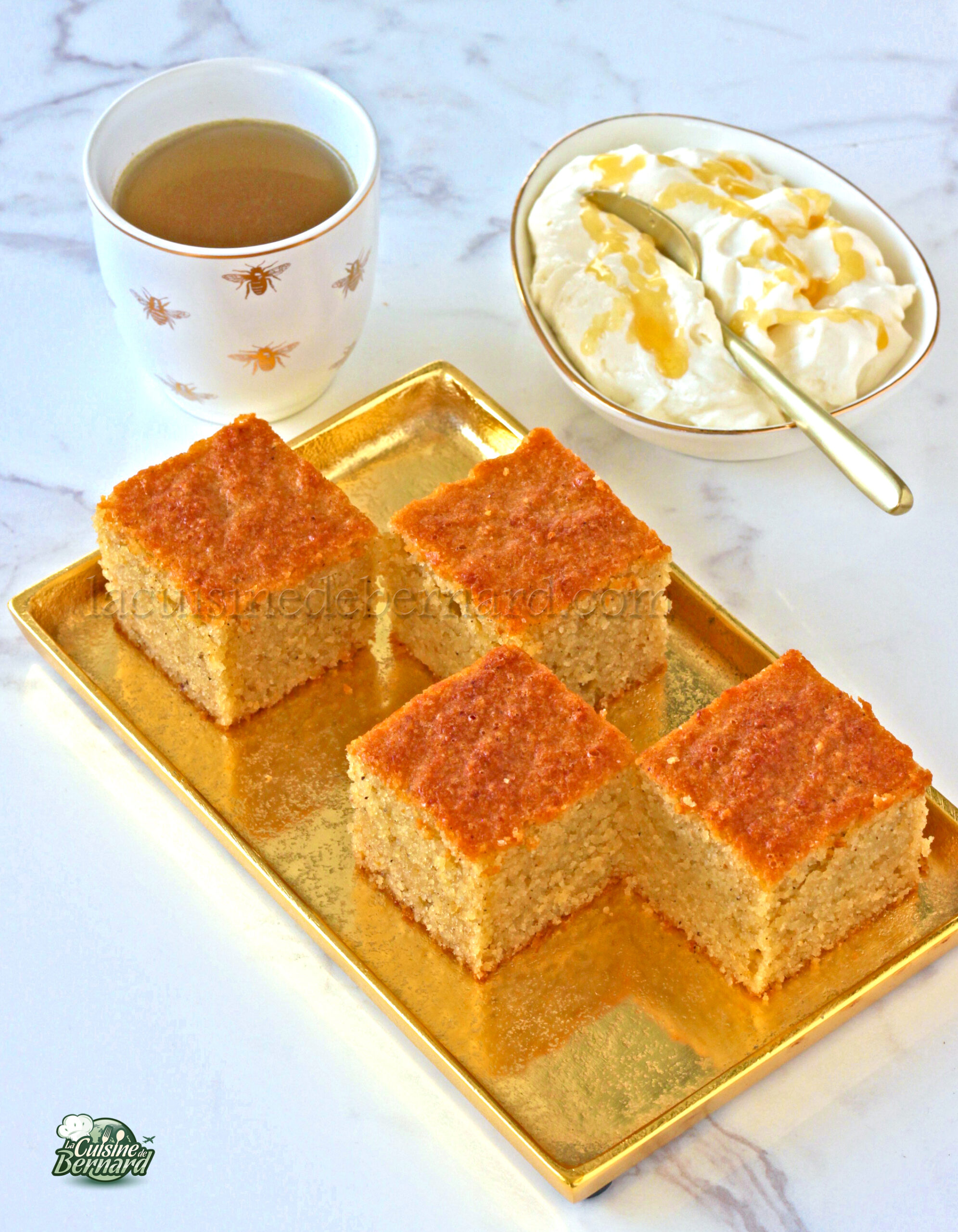
Here’s a delicious and surprising cake, with an almond base and a good taste of honey, but also with a rather unexpected ingredient that adds a lovely texture. It’s delicious on its own, well chilled or at room temperature, but even more so if accompanied by a totally addictive cream cheese and honey chantilly. It’s very simple, and takes just a few minutes to prepare.
For a 20 cm square mould :
- 300g of egg
- 150g liquid honey of your choice
- 175g rapeseed oil for cooking
- 35g brown sugar
- 250g almond powder
- 100g of breadcrumbs
- 1/2 teaspoon cinnamon powder
- 1/2 teaspoon baking powder
- 1/4 teaspoon of salt
For the honey and cream cheese chantilly :
- 300g cold cream cheese
- 150g cold full cream
- 70g of honey
- 25g chantifix
Pour the eggs, honey, oil and brown sugar into a bowl.
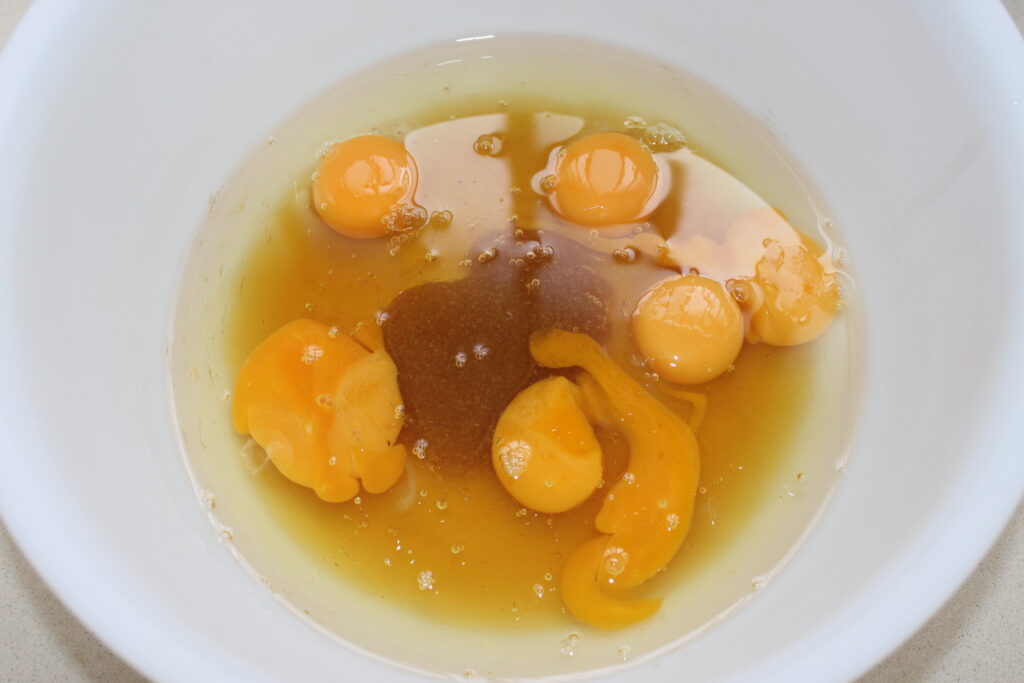
Mix, then add the almond powder, breadcrumbs, cinnamon, salt and baking powder.
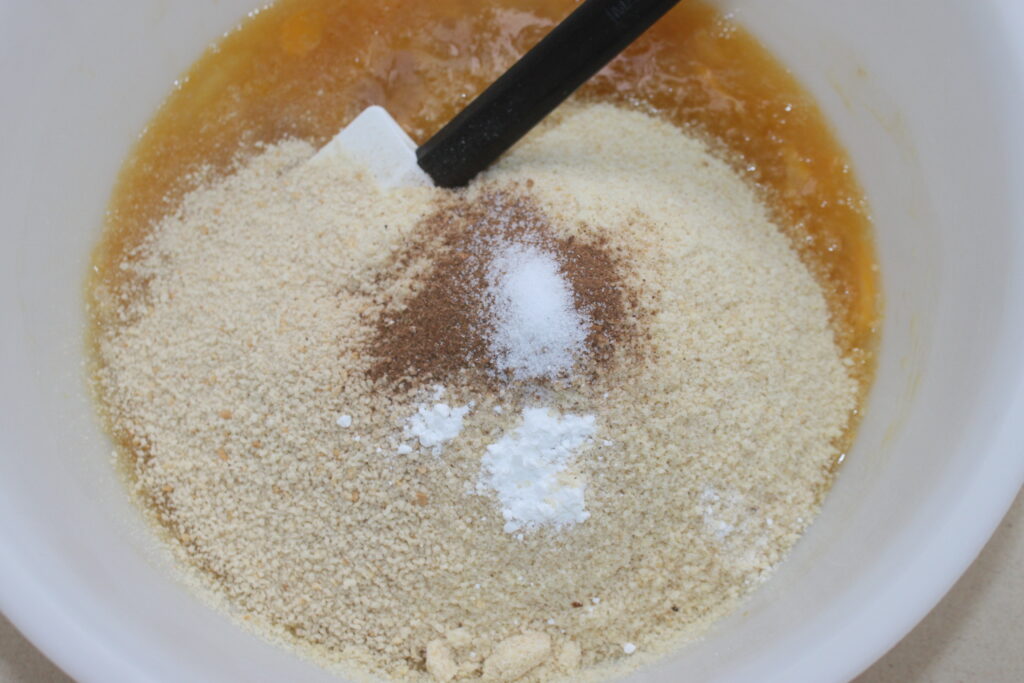
Mix well and leave to stand for 10 minutes.
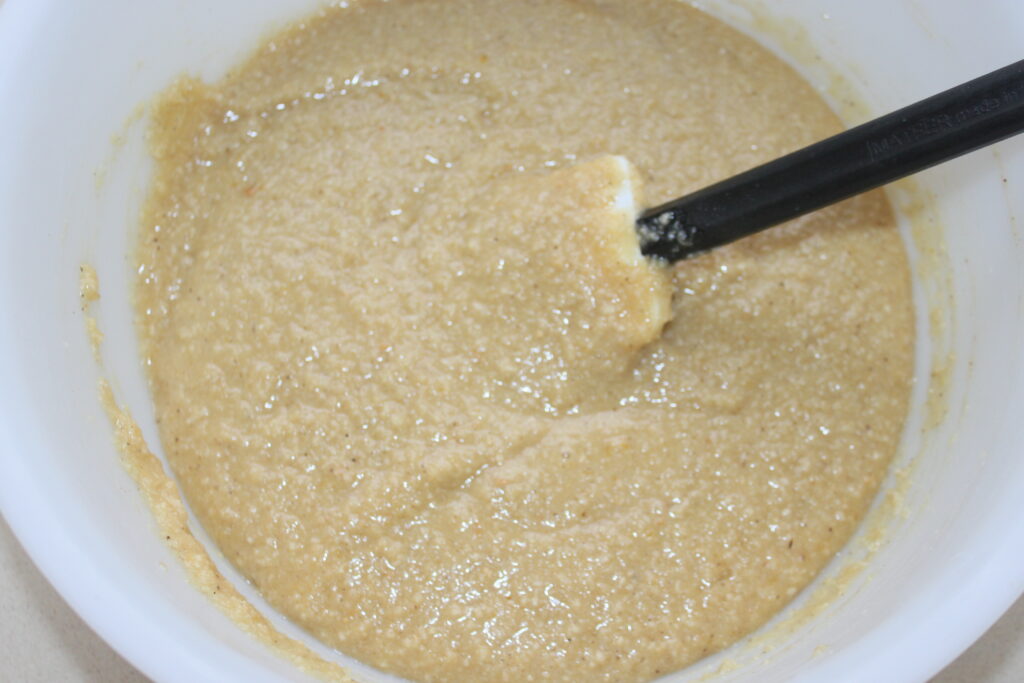
Pour into a square mould lined with baking parchment.
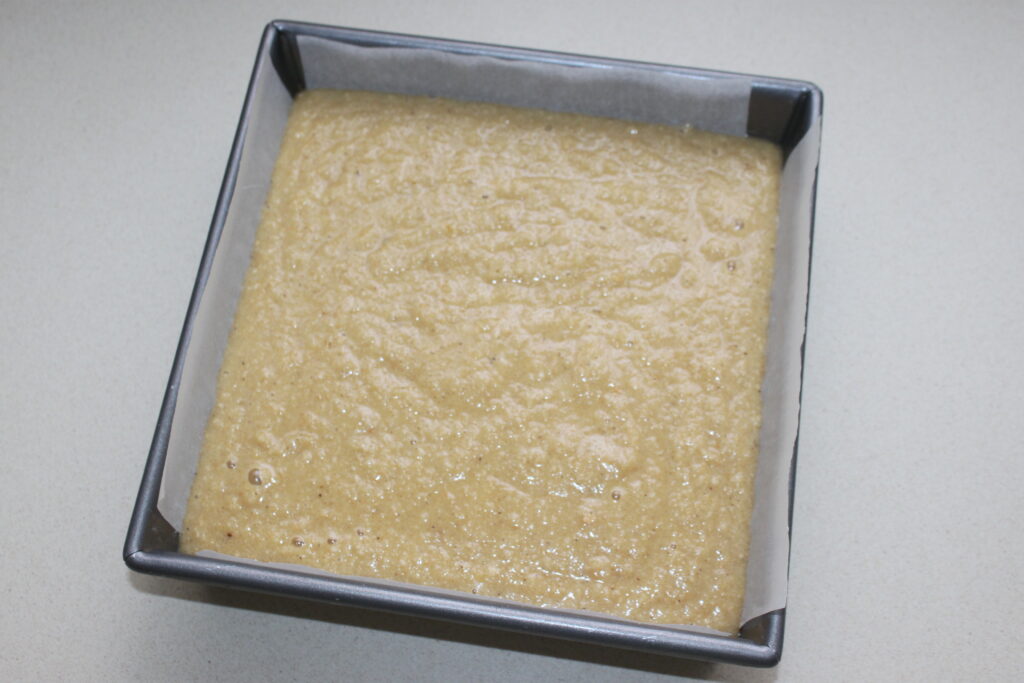
Bake at 170°C over static heat (not over revolving heat) for 40 minutes.
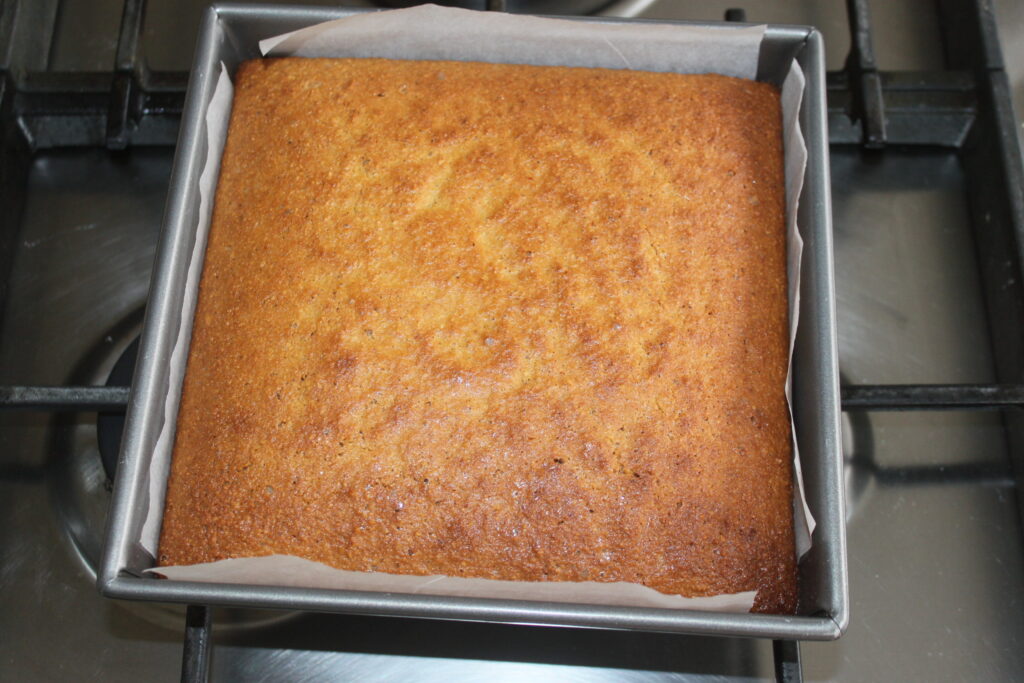
Turn out and leave to cool.

Then simply cut it into slices.
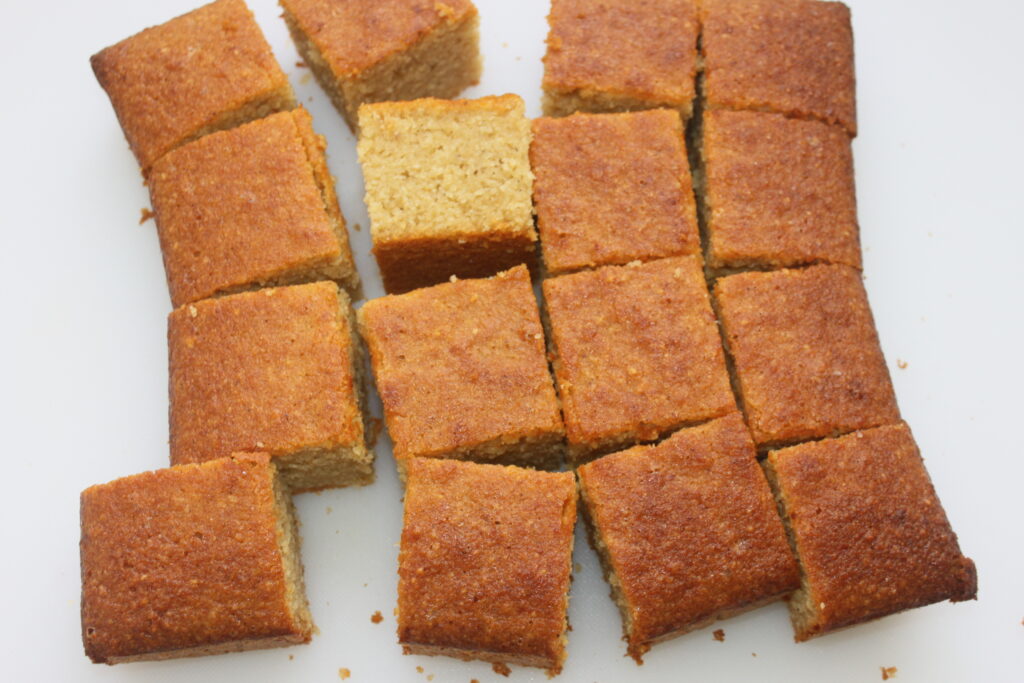
If you want to make the chantilly, pour all the ingredients except the chantifix into a container or into the bowl of your food processor.
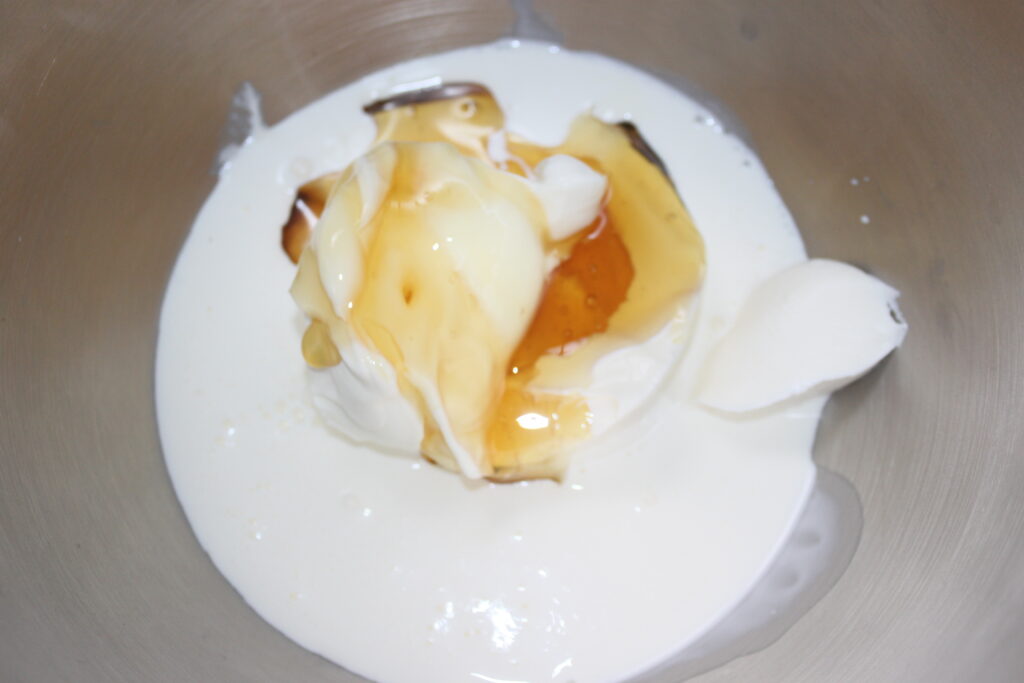
Whip at high speed.
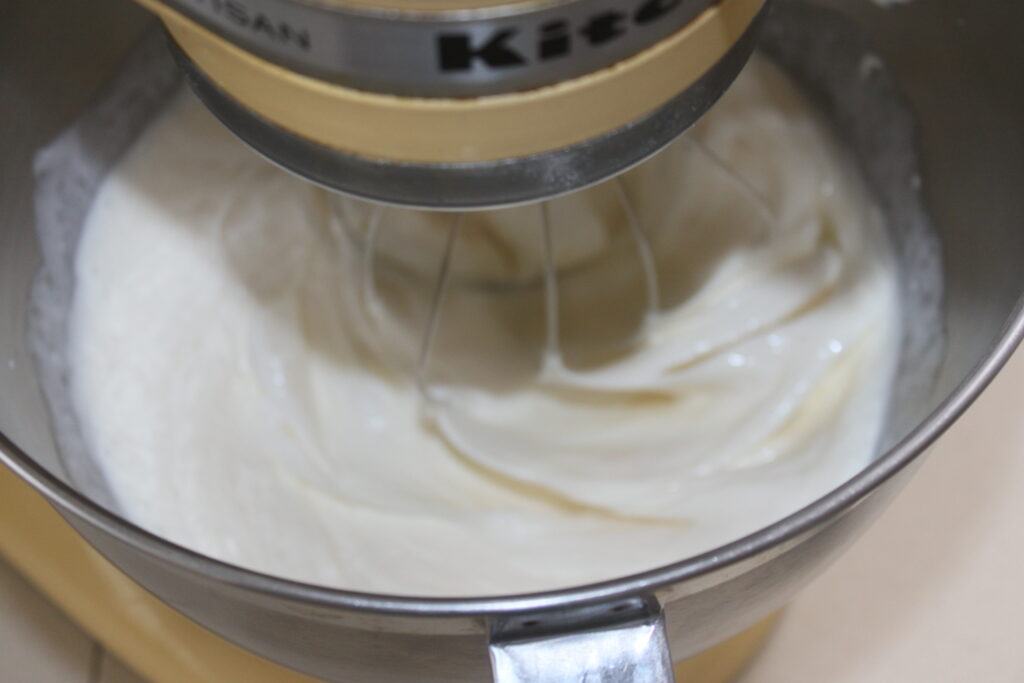
When the whipped cream has firmed, add the chantifix and whisk again to obtain a firm texture.
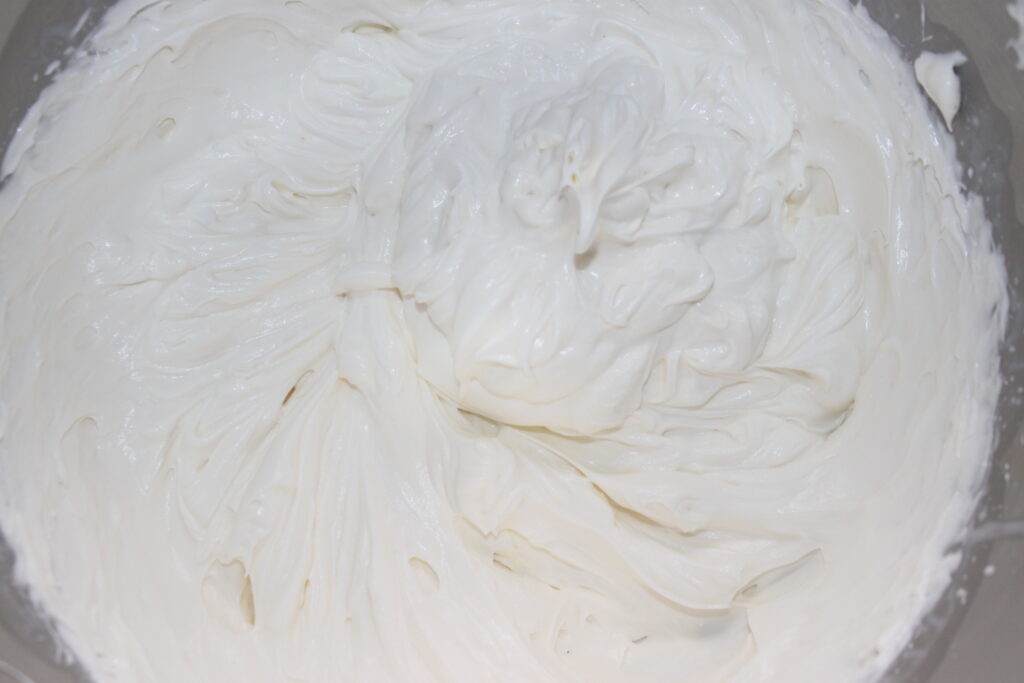
Serve the cake at teatime with whipped cream on hand!
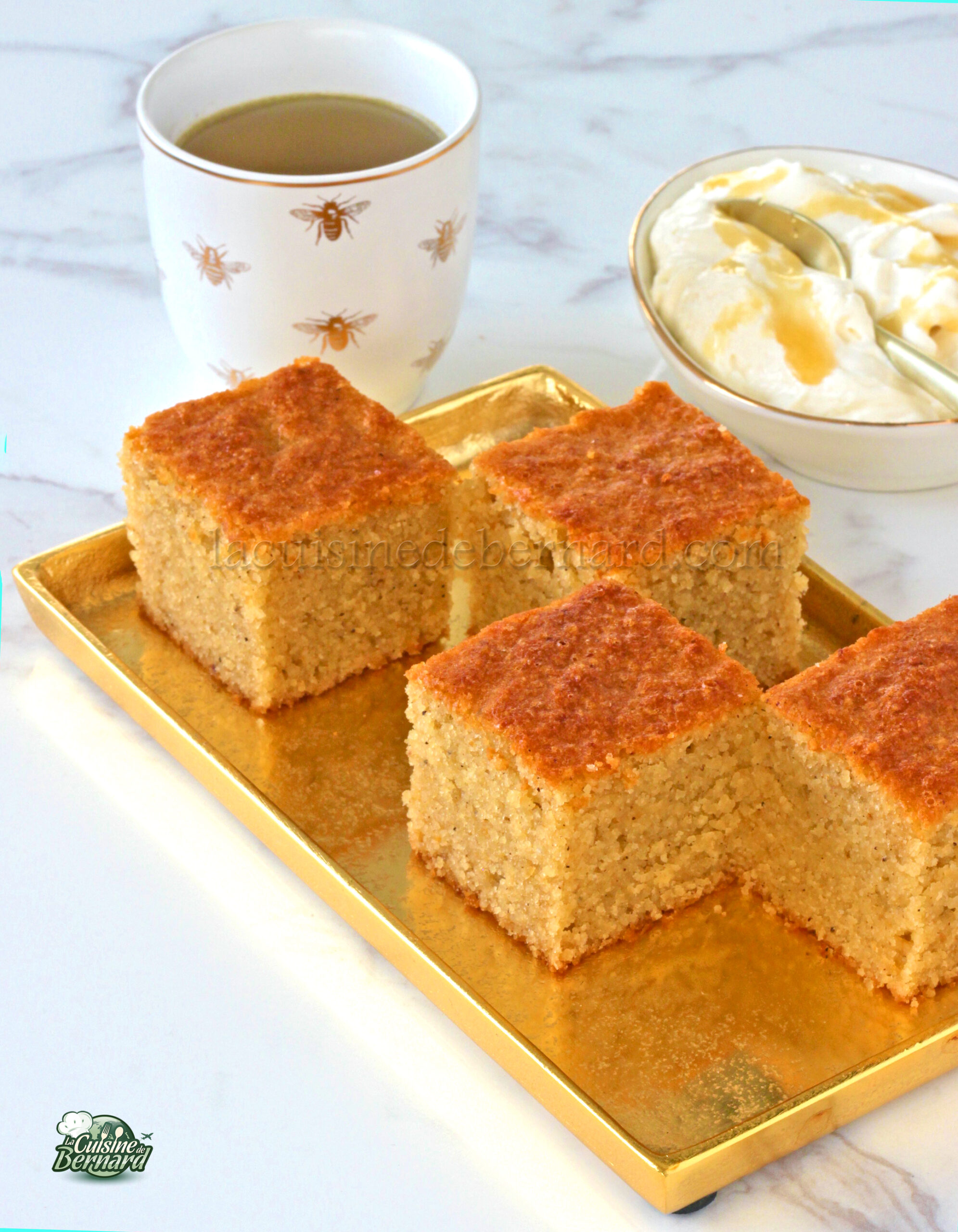
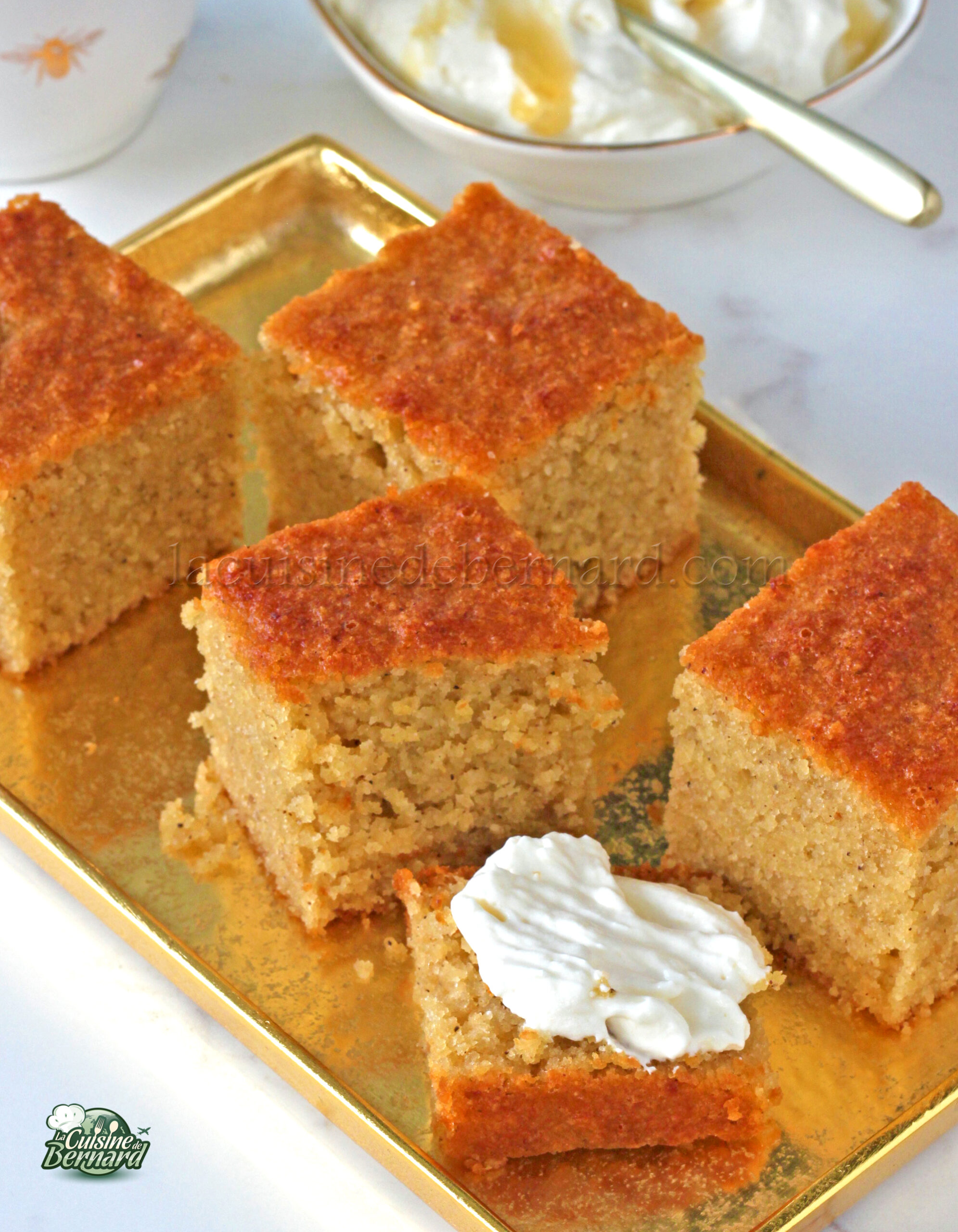
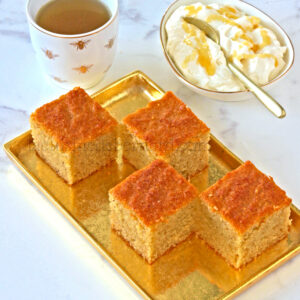
Honey almond cake
Ingredients
For a 20 cm square mould
- 300 g egg
- 150 g liquid honey
- 175 g rapeseed oil for cooking
- 35 g brown sugar
- 250 g almond powder
- 100 g breadcrumbs
- 1/2 c. coffee powdered cinnamon
- 1/2 c. coffee baking powder
- 1/4 c. coffee salt
For the cream cheese and honey chantilly
- 300 g cream cheese nice and cold
- 150 g full-fat liquid cream very cold
- 70 g honey
- 25 g chantifix
Instructions
- Pour the eggs, honey, oil and brown sugar into a bowl.
- Mix, then add the almond powder, breadcrumbs, cinnamon, salt and baking powder.
- Mix well and leave to stand for 10 minutes.
- Pour into a square mould lined with greaseproof paper.
- Bake at 170°C over static heat (not over revolving heat) for 40 minutes.
- Turn out and leave to cool. Then simply cut it into slices.
- If you want to make the chantilly, pour all the ingredients except the chantifix into a container or into the bowl of your food processor. Whip at high speed.
- When the whipped cream has firmed, add the chantifix and whisk again to obtain a firm texture.
- Serve the cake at teatime with whipped cream on hand!
Nutrition
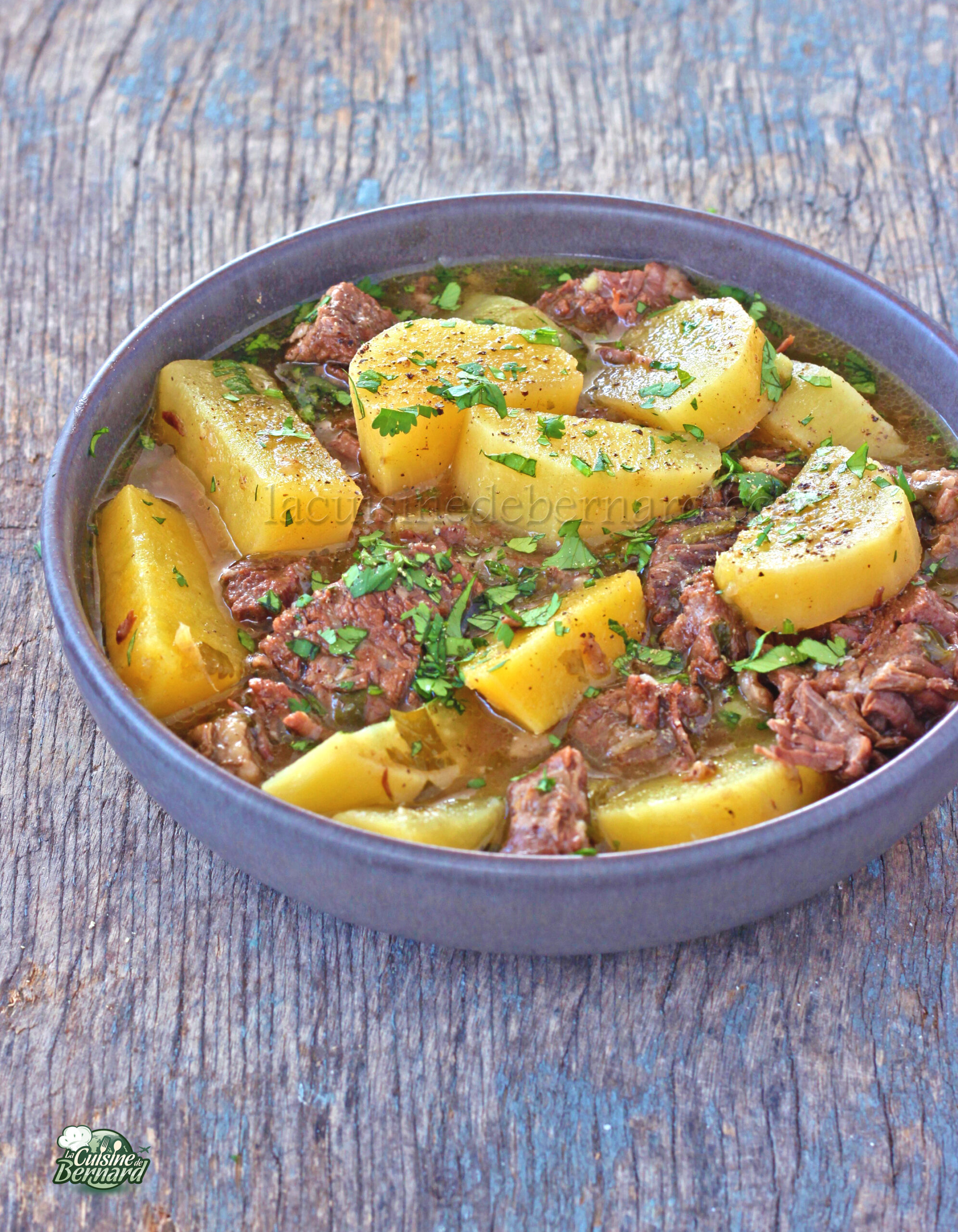
I’m lucky enough to have a market gardener who offers quite a few exotic vegetables, including the classic orange sweet potatoes, but also the firmer-textured white ones that I’m particularly fond of. I’d bought some, and they’d been lying around in my kitchen for a while. They keep very well. But I went into a recipe a bit on the spur of the moment, not knowing how it would turn out. The result was delicious, with a very tasty sauce. The meat is tender and juicy to perfection, and the white sweet potato is both firm and melt-in-the-mouth. A little feast!
Recipe for 6 to 8 people:
- 1.5 kg of meat (I used rib-eye steak)
- 1 or 2 marrow bones
- 2 onions
- 8 garlic cloves
- 5cm fresh ginger
- 1 or 2 bird peppers
- 2 liters chicken or vegetable stock
- 3 tablespoons wine vinegar
- 3 tablespoons Worcestershire sauce
- 3 large white sweet potatoes (or more, depending on size!)
- 1 small bunch of coriander
- 3-4 teaspoons rice flour or potato starch
- salt pepper
For this recipe, I used low ribs, ideal for this type of recipe. I also have a marrow bone, but you could use more.
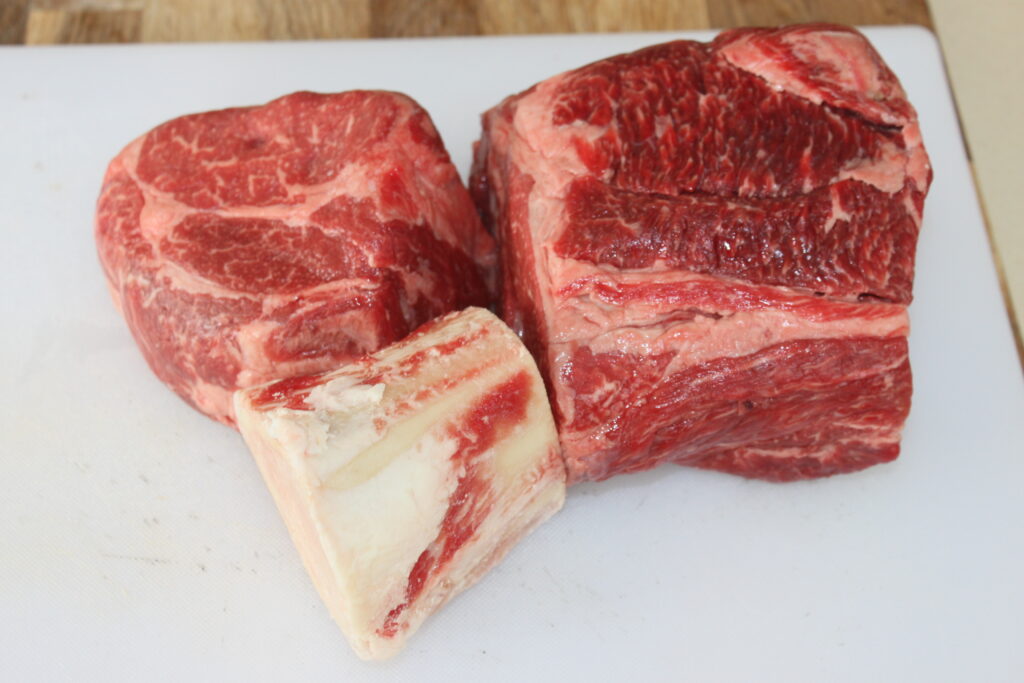
Cut the meat into 3-4cm cubes.
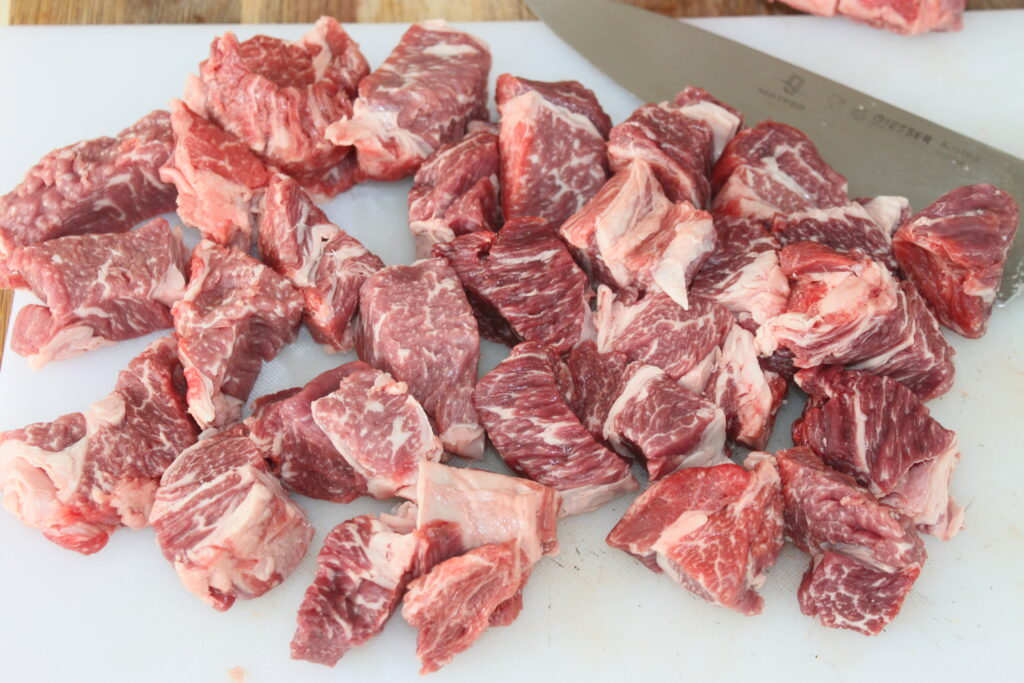
Place in a casserole dish with a tablespoon of oil over high heat.
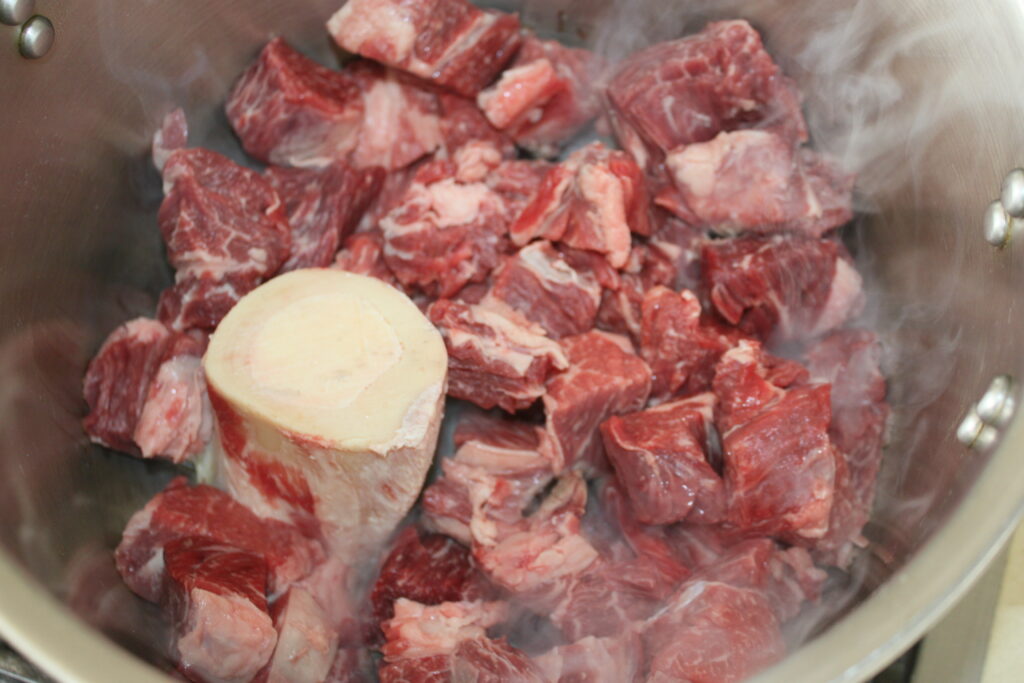
Simmer for 10-15 minutes, stirring occasionally. Meanwhile, peel and chop the onions, garlic cloves and ginger,
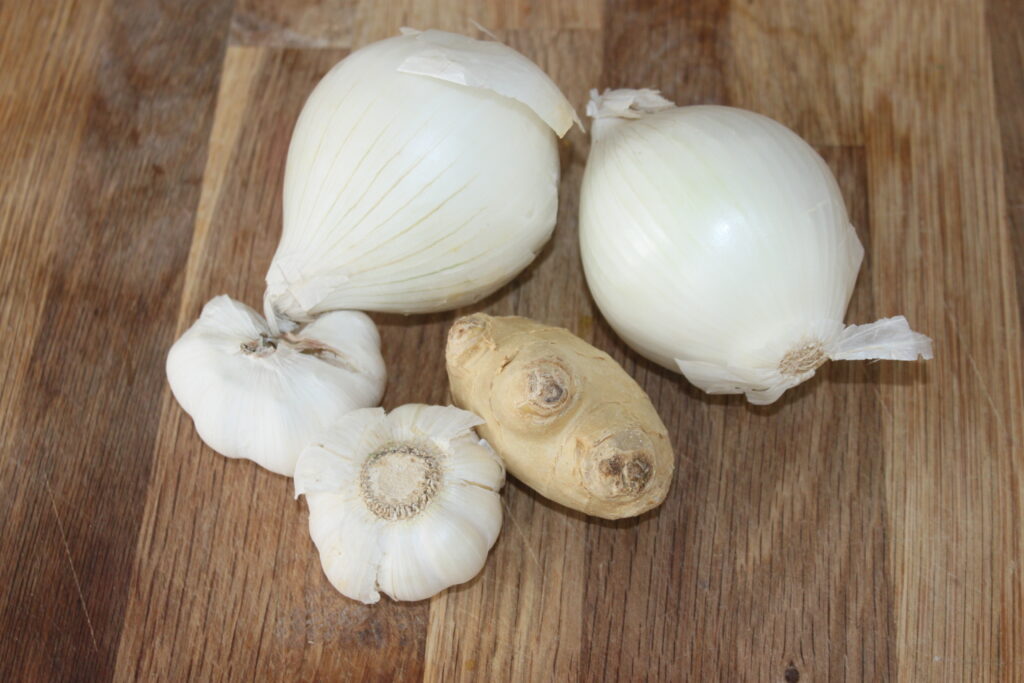
For the onion, in classic chunks.
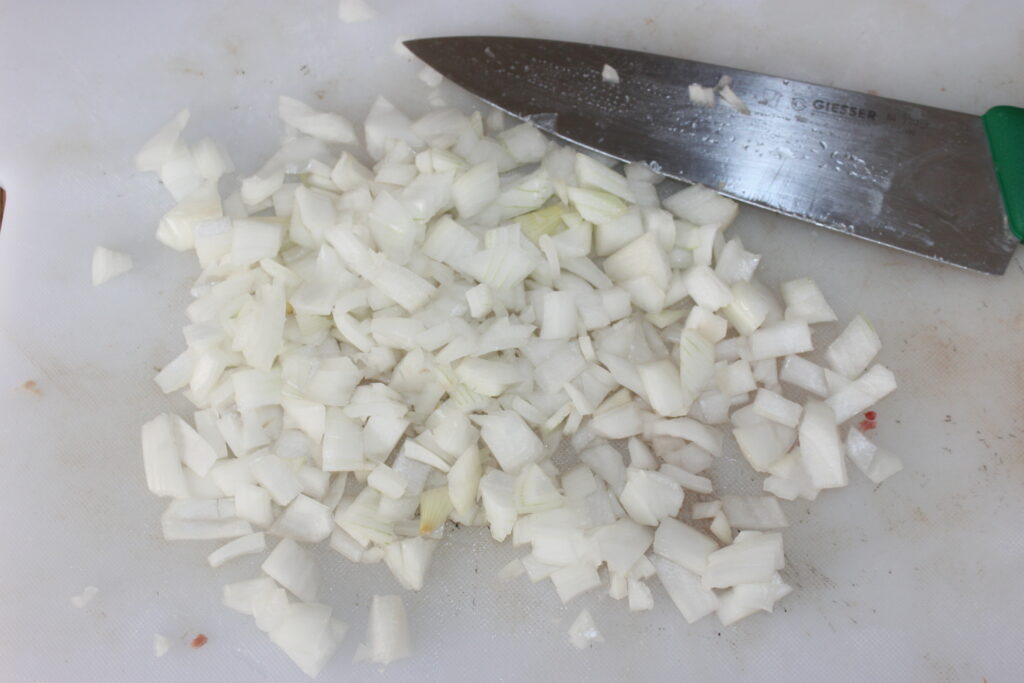
Garlic and ginger require finer chopping.
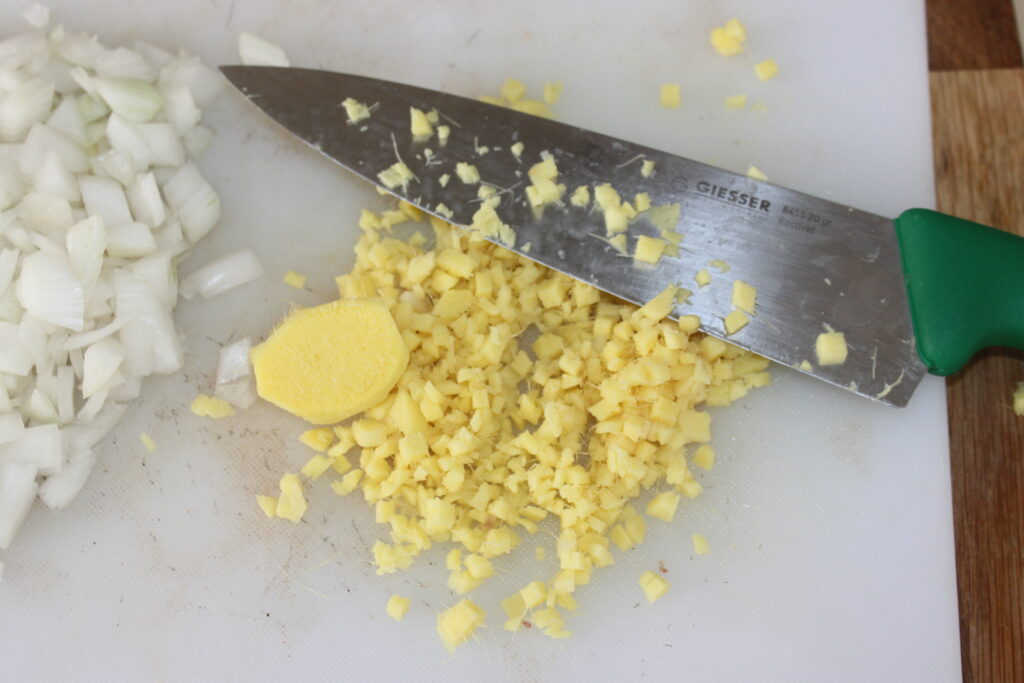
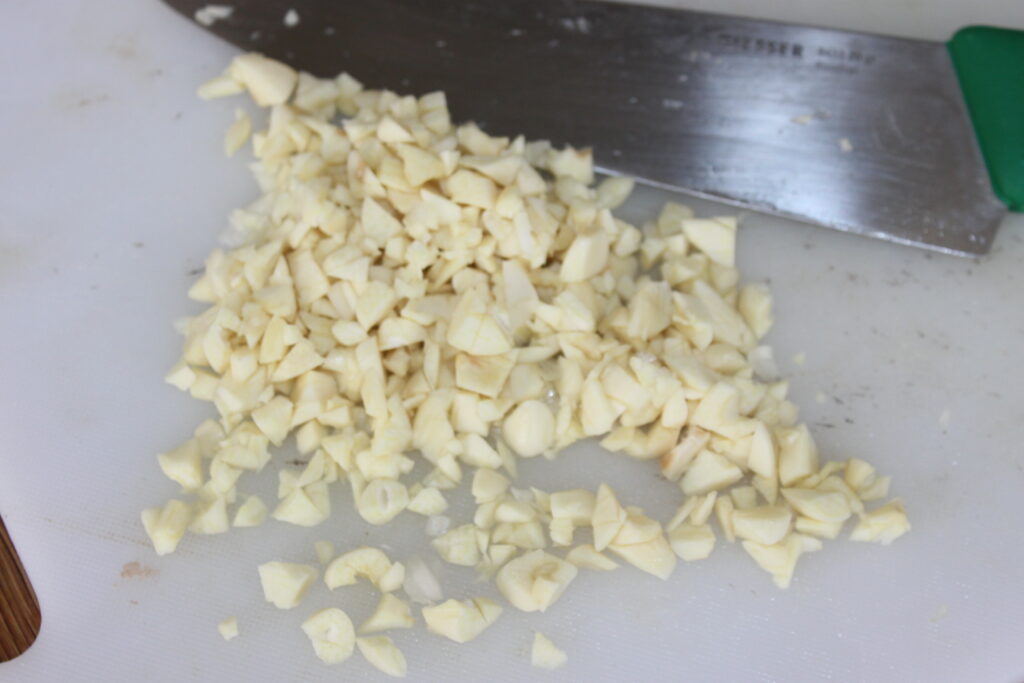
Pour into the casserole dish.
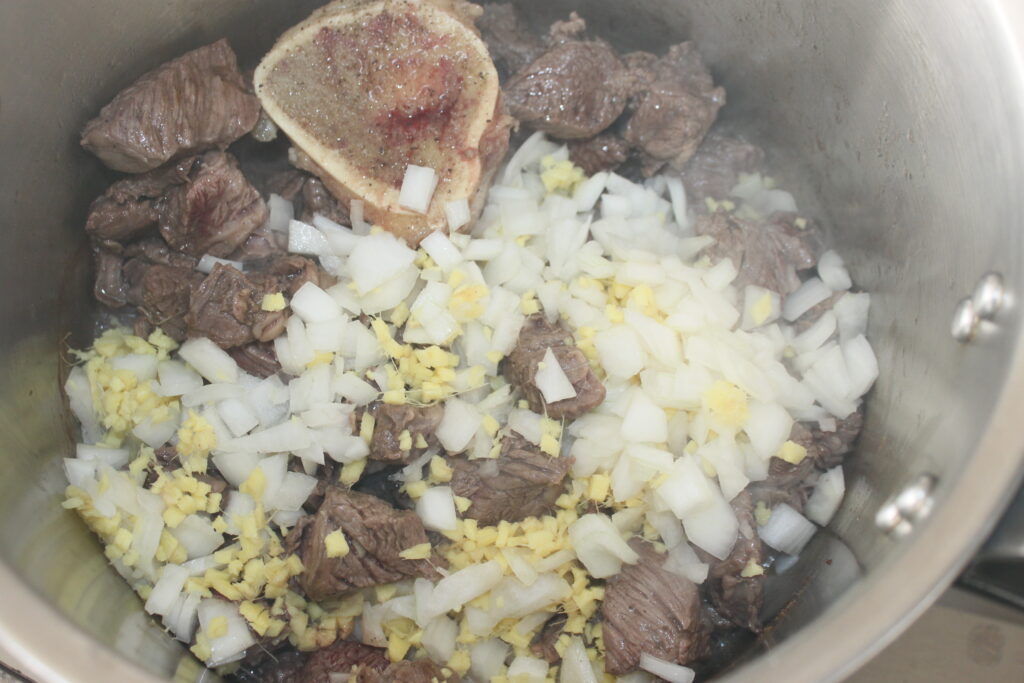
Cook and stir for 5 minutes.
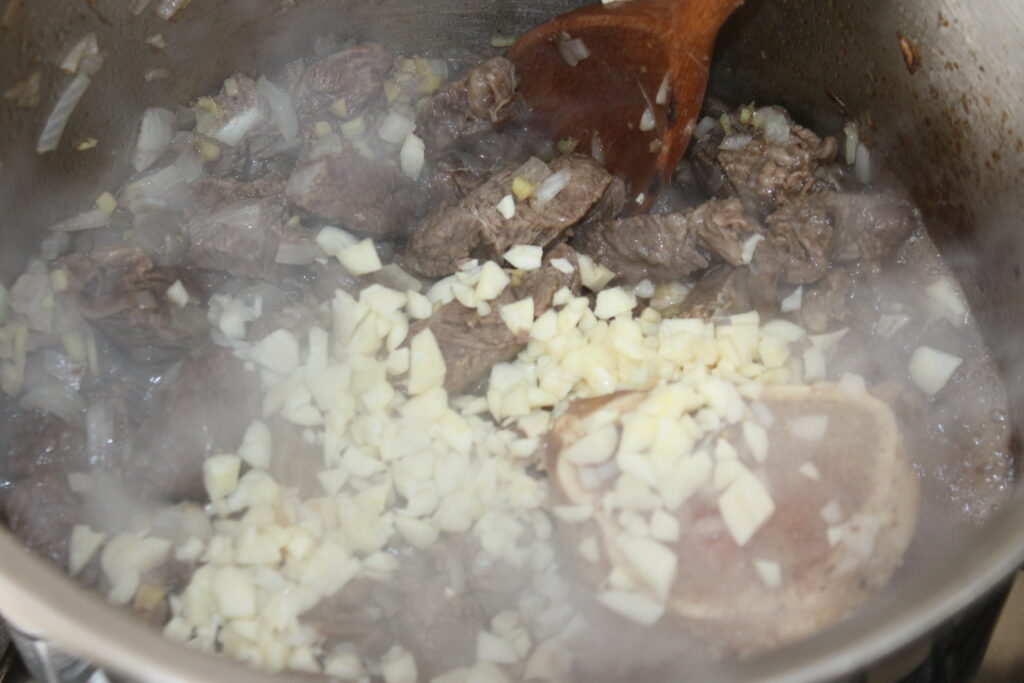
Finely chop the bird pepper(s). You can leave the seeds in or remove them for less pungency.
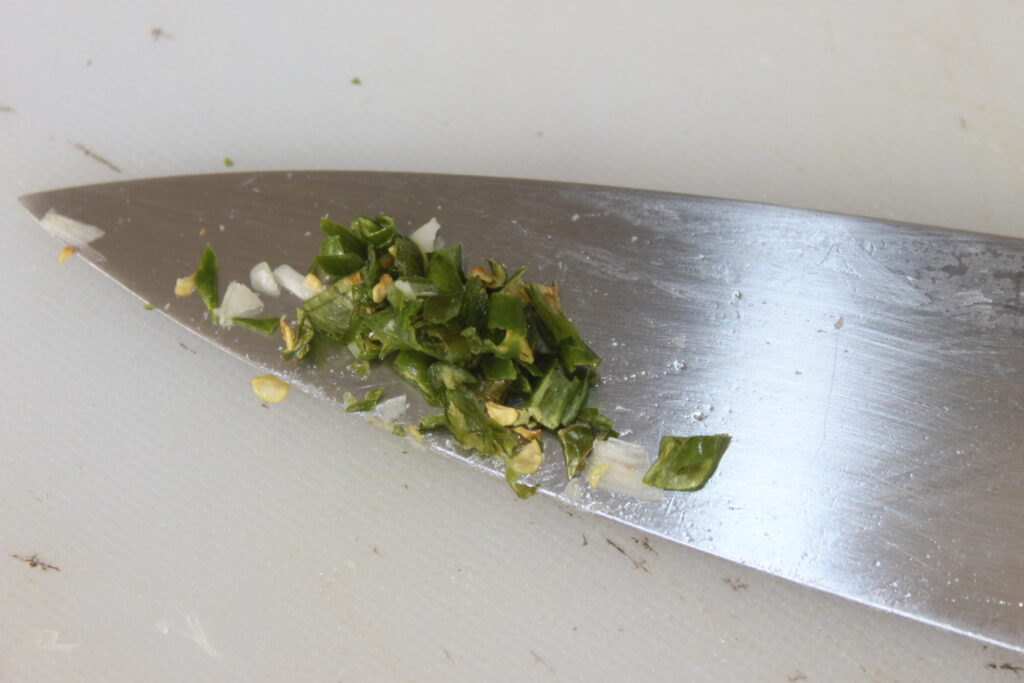
Pour into the casserole dish, then add chicken (or vegetable) stock up to the level of the meat.
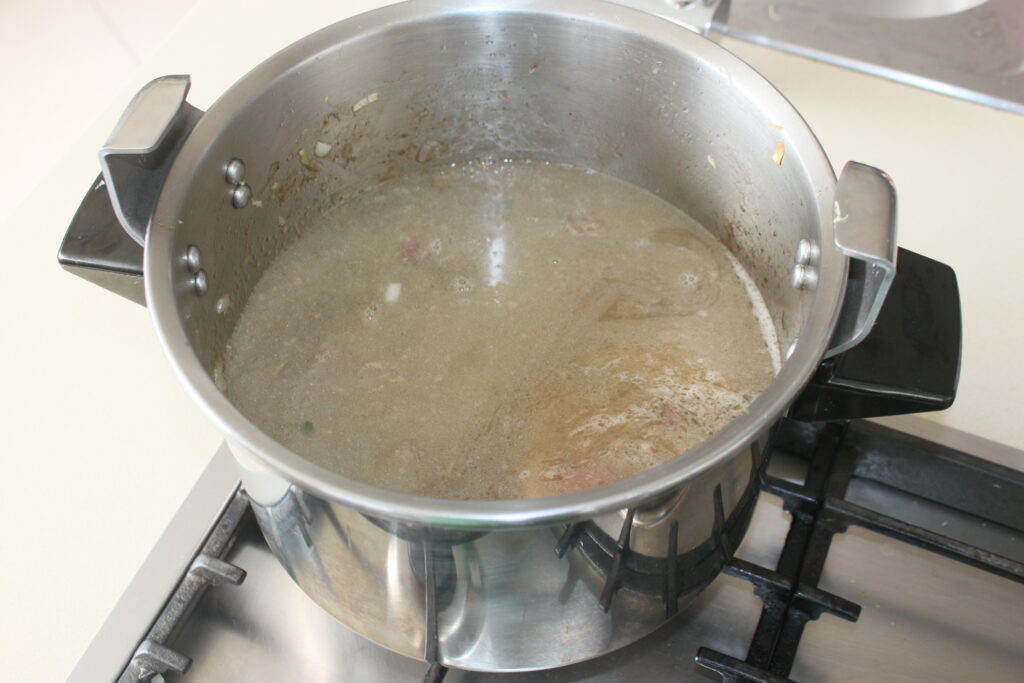
I put the pressure on here and let it cook with the steam hissing for 1h30. Without a pressure cooker, cooking time is doubled.
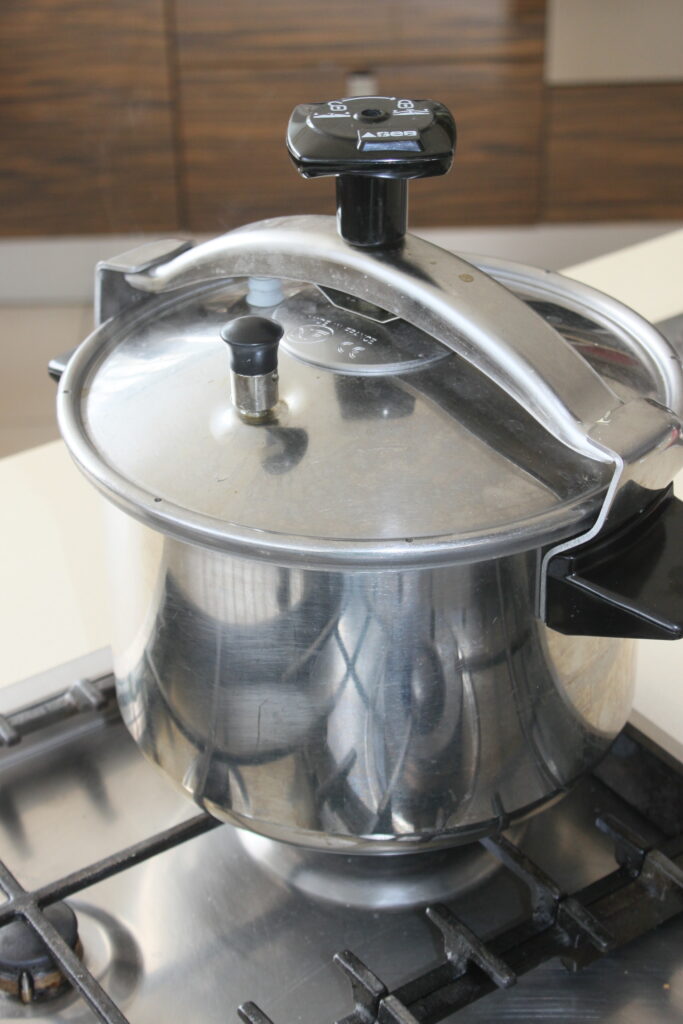
After this cooking time, pour in the Worcestershire sauce and wine vinegar.
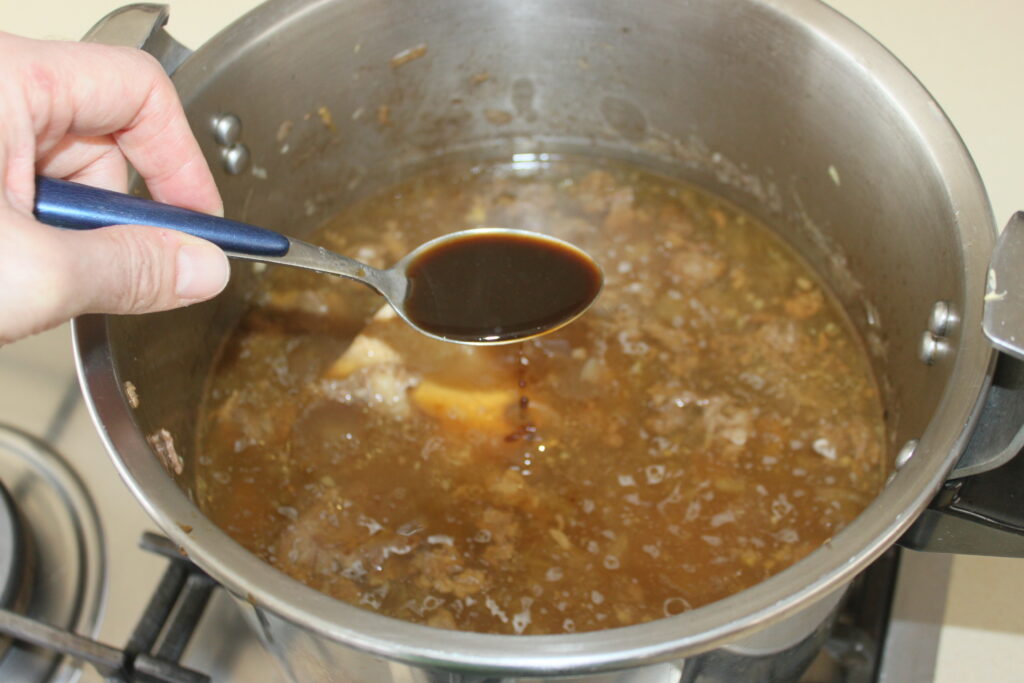
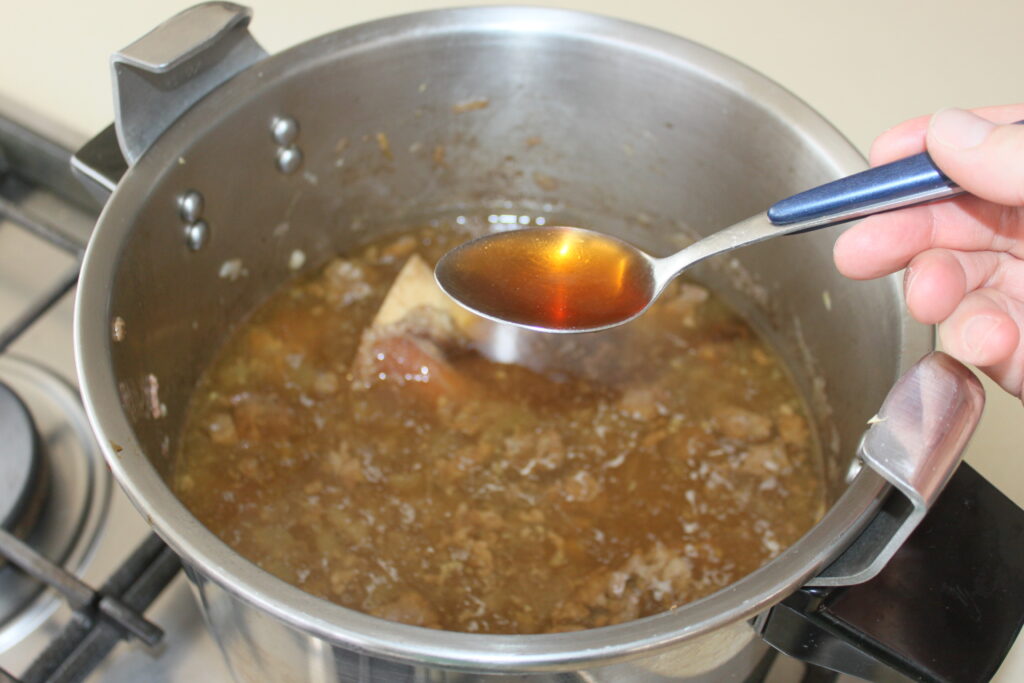
Check that the meat is cooked through, as it should be very soft at this stage.
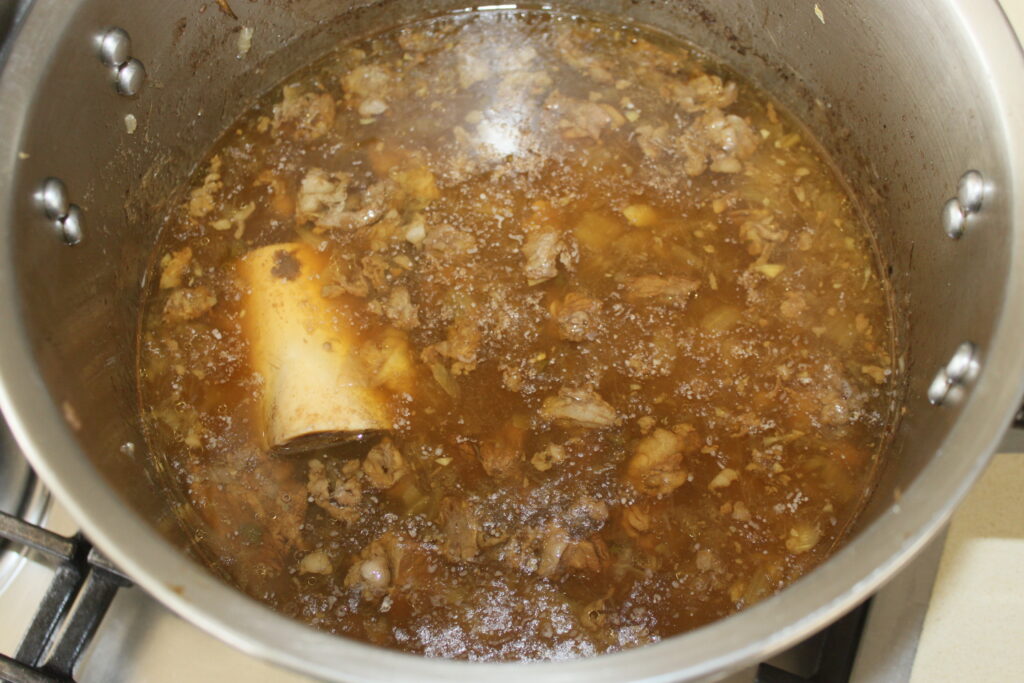
If it’s good, leave to cool completely before chilling to set the fat and get rid of some of it. I therefore advise you to do this first cooking the day before your meal.
For the next day. Here are the white sweet potatoes. I’m lucky enough to have a market gardener who sells them. The texture is very different from that of orange sweet potatoes. It is firmer, less sweet and almost chestnut-like. Of course, you can also use the classic sweet potato and adapt the cooking to it.
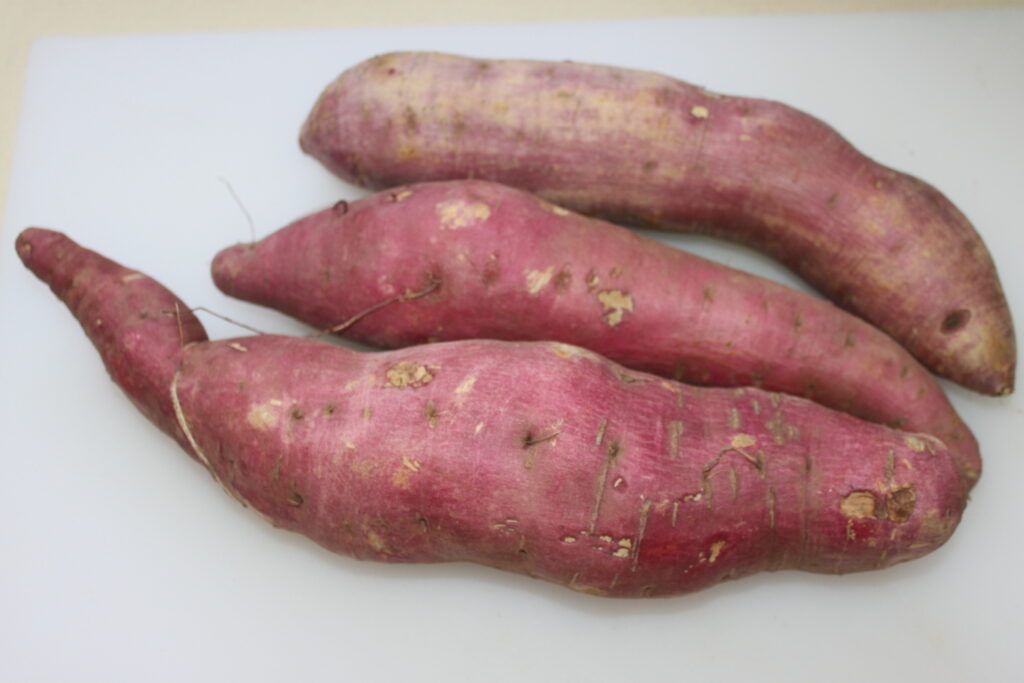
They need to be peeled, then cut into pieces.
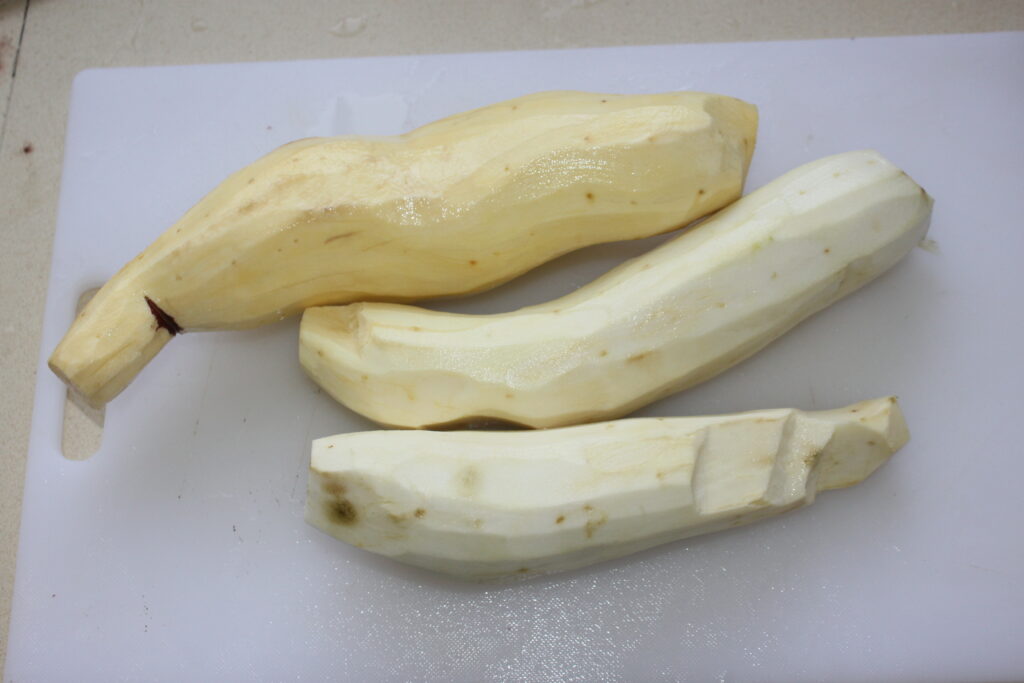
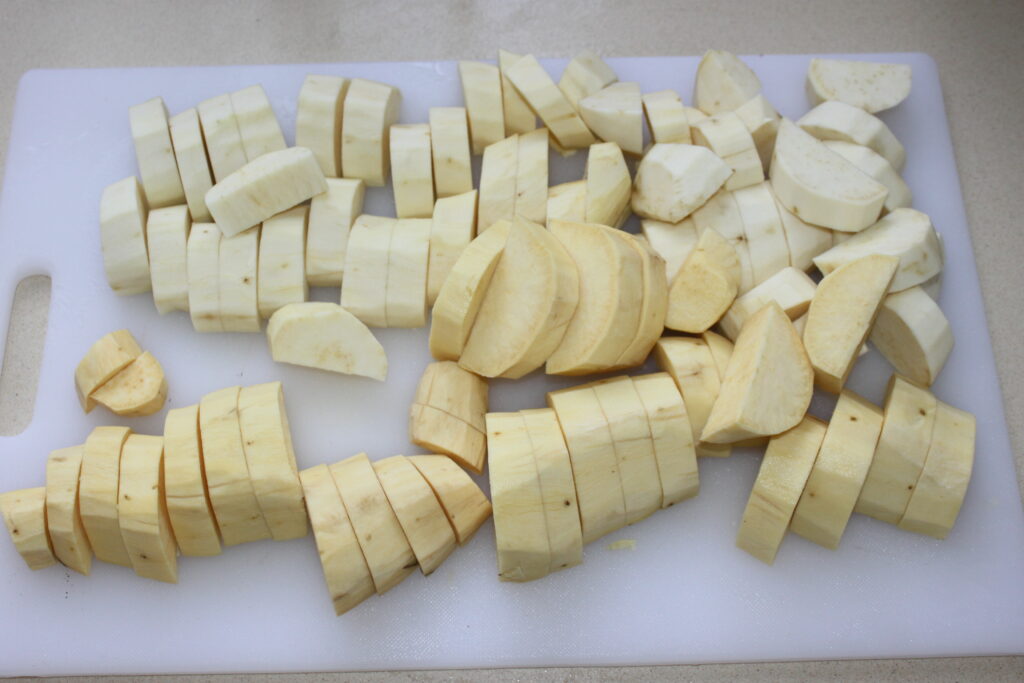
Remove the casserole from the fridge and remove any fat that has congealed. This way, it’s up to you to decide how much fat to leave.
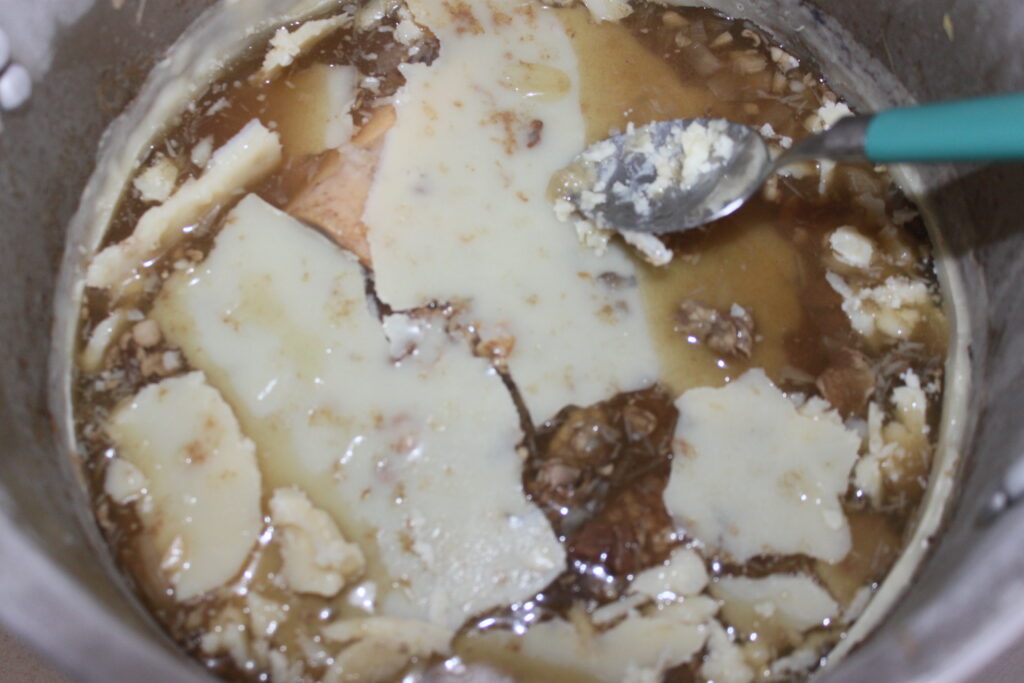
Remove the meat and bone from the stock and set aside.
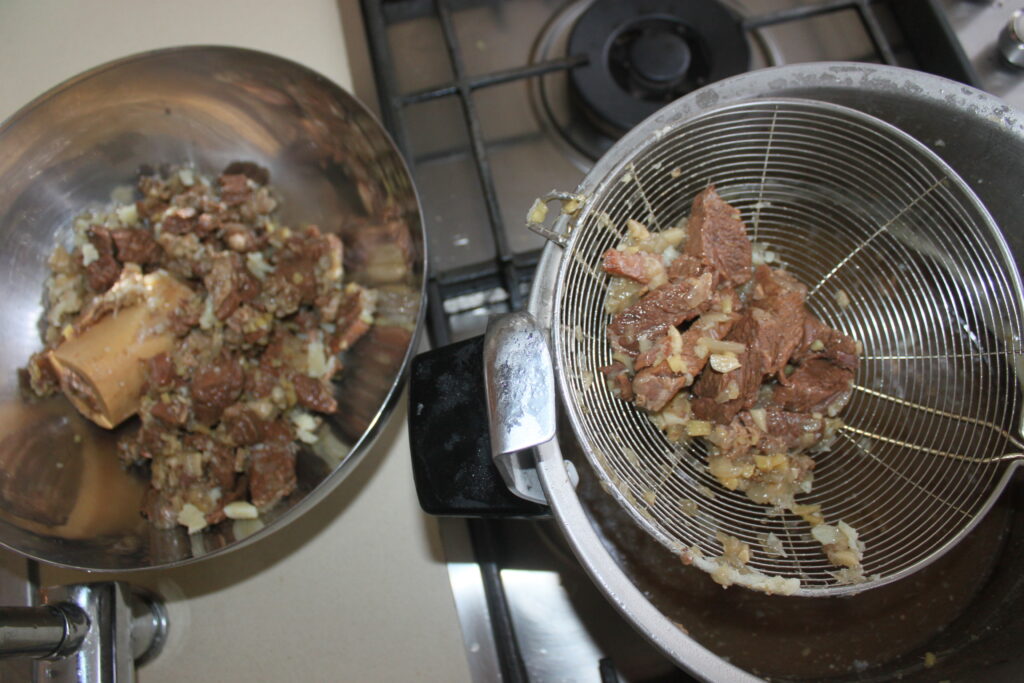
Add the sweet potatoes and bring to the boil, uncovered. Chop the small bunch of coriander, washed and squeezed dry, and add to the sweet potatoes. Put salt and pepper at your taste.
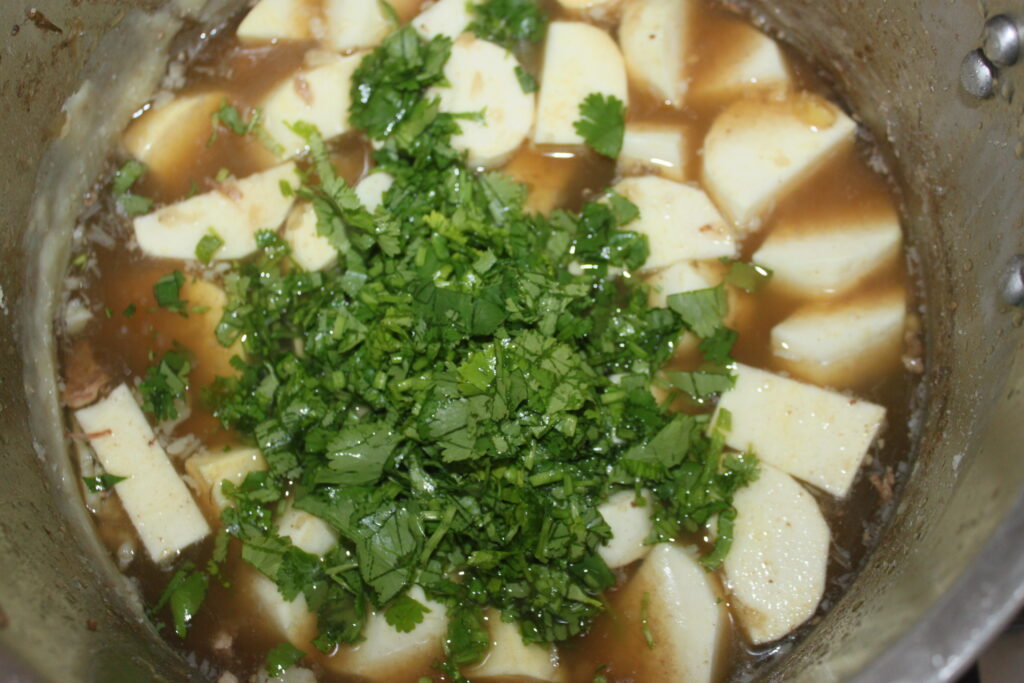
Leave to cook for 20-25 minutes and check with a fork. Pour the rice flour into a small bowl and add about 50g of water. Pour this mixture into the boiling liquid, stirring gently to thicken the sauce to your liking. So you don’t necessarily have to pour it all in, or on the contrary, add more, to adapt to the desired consistency. I wanted a sauce with just a touch of glaze.
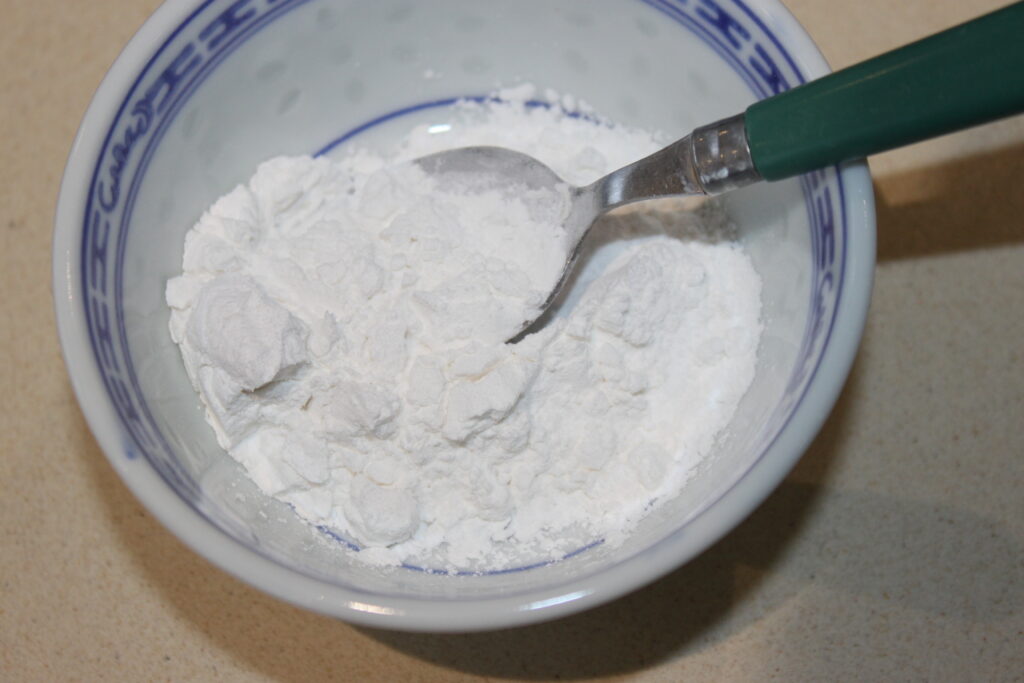
When ready, add the meat and cook for 10 minutes until heated through.
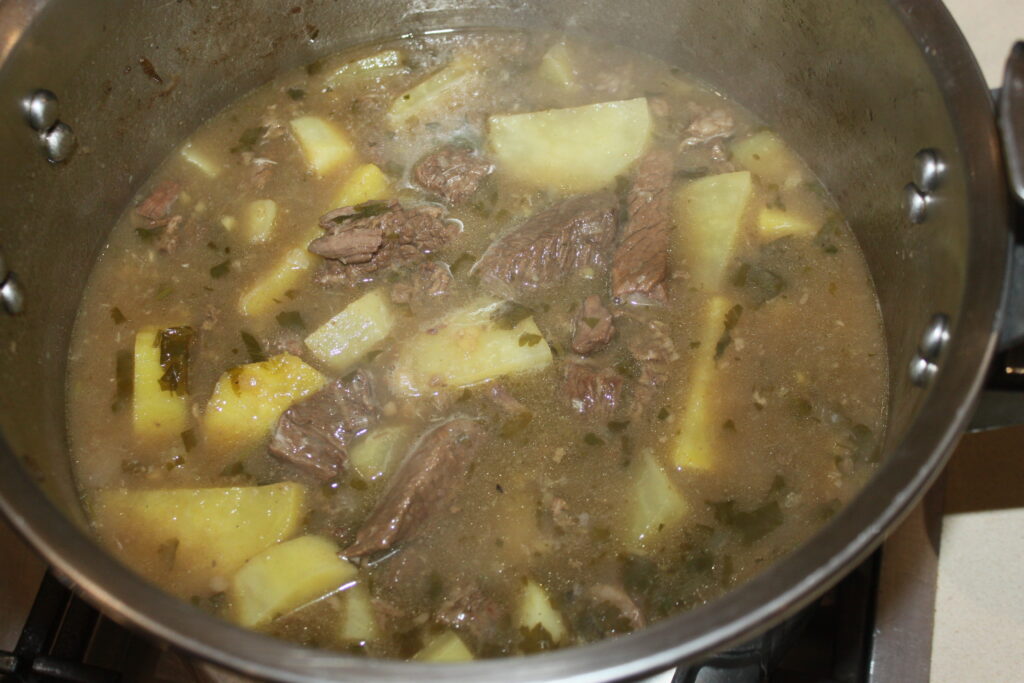
Serve the stew well chutneyed, with a sprinkling of freshly chopped coriander.
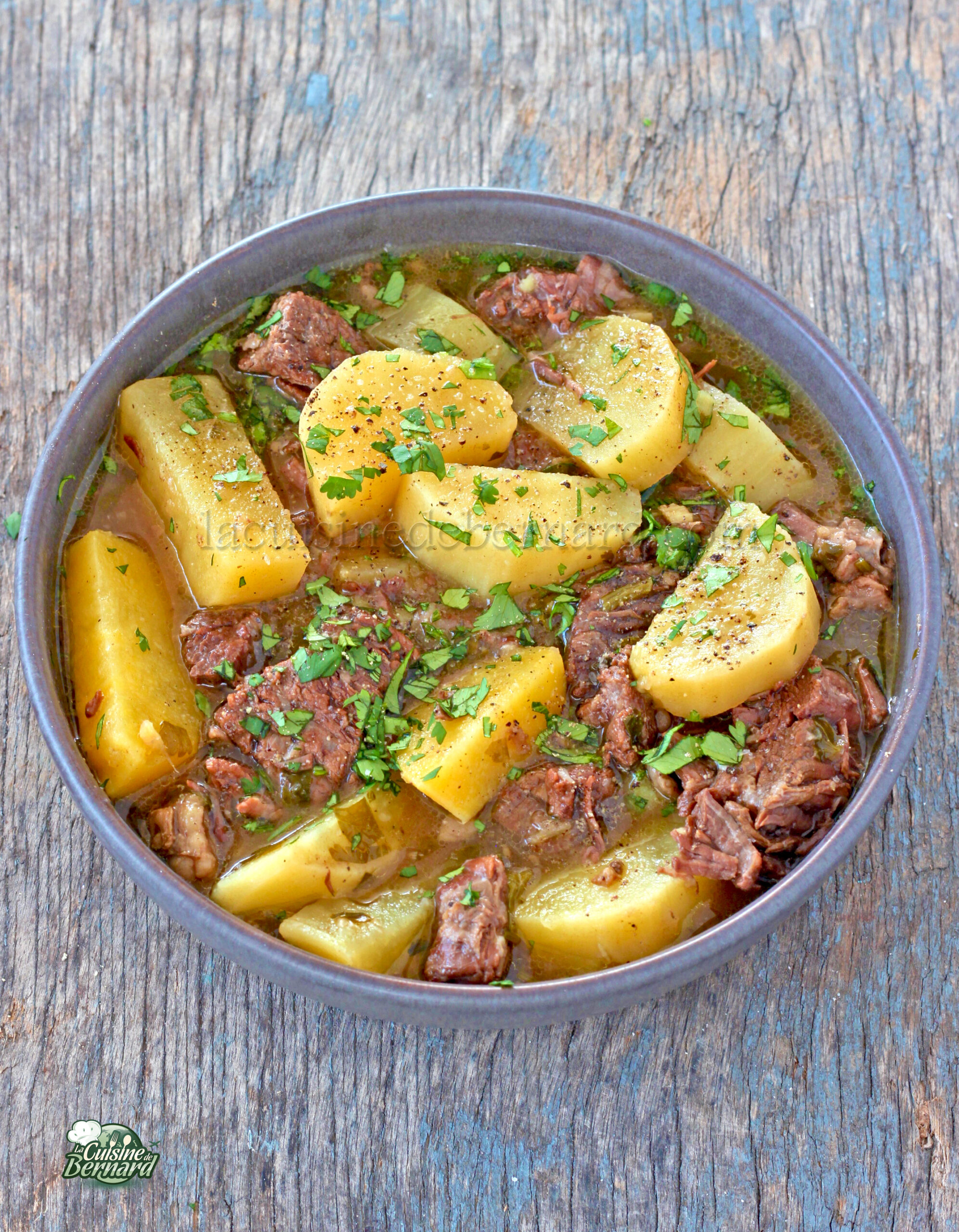
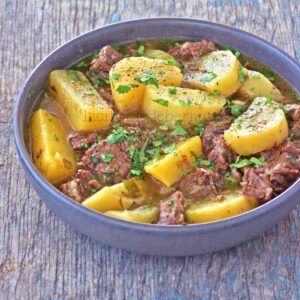
Daube de bœuf, ail gigembre et patates douces blanches
Ingredients
- 1,5 kg viande de bœuf ici basse côte
- 2 os à moelle
- 2 oignons
- 8 gousses d'ail
- 5 cm gingembre frais
- 2 piments oiseaux
- 2 litres bouillon de volaille ou de légume
- 3 c. à soupe vinaigre de vin
- 3 c. à soupe sauce Worcestershire
- 3 patates douces blanches
- 1 petit bouquet de coriandre
- 4 c. à café farine de riz ou fécule de pomme de terre
- sel, poivre
Instructions
- Pour cette recette, j’ai pris de la basse côte, idéale pour ce genre de recette. J’ai aussi un os à moelle, mais on peut mettre davantage. Coupez la viande en morceaux cubiques de 3-4cm.
- Placez dans une cocotte avec une cuillerée à soupe d’huile sur feu fort.
- Laissez mijoter 10-15 minutes en remuant de temps en temps. Pendant ce temps, épluchez et coupez en petits morceaux les oignons, les gousses d’ail et le gingembre.,
- Pour l’oignon, en morceaux classiques. Pour l’ail et le gingembre, il faudra hacher plus finement. Versez le tout dans la cocotte.
- Laissez cuire en mélangeant pendant 5 minutes.
- Hachez finement le ou les piments oiseaux. Vous pouvez laisser les graines ou les ôter pour moins de piquant.
- Versez dans la cocotte puis versez du bouillon de volaille (ou de légume) jusqu’au niveau de la viande.
- J’ai mis ici la pression et j’ai laissé cuire avec le sifflement de la vapeur pendant 1h30. Sans cocotte minute sans pression, le temps de cuisson est doublé.
- Après ce temps de cuisson, versez la sauce Worcestershire et le vinaigre de vin.
- Vérifiez la cuisson de la viande qui doit être très fondante à ce stade.
- Si c’est bon, laissez refroidir totalement avant de mettre au frais pour figer le gras et s’en débarrasser en partie. Je conseille donc de faire cette première cuisson la veille de votre repas.Pour le lendemain. Voici les patates douces blanches. J’ai la chance d’avoir un maraicher qui en vend. La texture est très différente de la patate douce orangée. Elle est plus ferme, moins sucrée, ressemble presque à de la châtaigne. Bien sûr, vous pouvez mettre la patate douce classique et adaptez la cuisson à cette dernière.
- Il faut les éplucher, puis les couper en morceaux.
- Sortez la cocotte du frais et enlevez la partie grasse qui a figé. De cette façon, c’est à vous de décider la quantité de gras laissée.
- Enlevez la viande et l’os du bouillon, réservez.
- Placez les patates douces puis portez à ébullition, sans couvercle. Hachez le petit bouquet de coriandre, lavé et essoré, ajoutez le tout avec les patates douces. Salez et poivrez à votre goût.
- Laissez cuire 20-25 minutes et vérifiez la cuisson en y plantant une fourchette. Versez la farine de riz dans un petit bol et ajoutez environ 50g d’eau. Versez cette préparation dans le liquide bouillant tout en remuant délicatement pour épaissir la sauce à votre goût. Il ne faut donc pas forcément tout verser, ou au contraire en ajouter davantage, pour adapter à la consistance voulue. J’ai voulu une sauce juste nappante.
- Quand c’est prêt, ajoutez la viande et laissez cuire 10 minutes pour que le tout soit bien chaud.
- Servez la daube bien chuade, avec un peu de coriandre fraichement hachée.
Nutrition
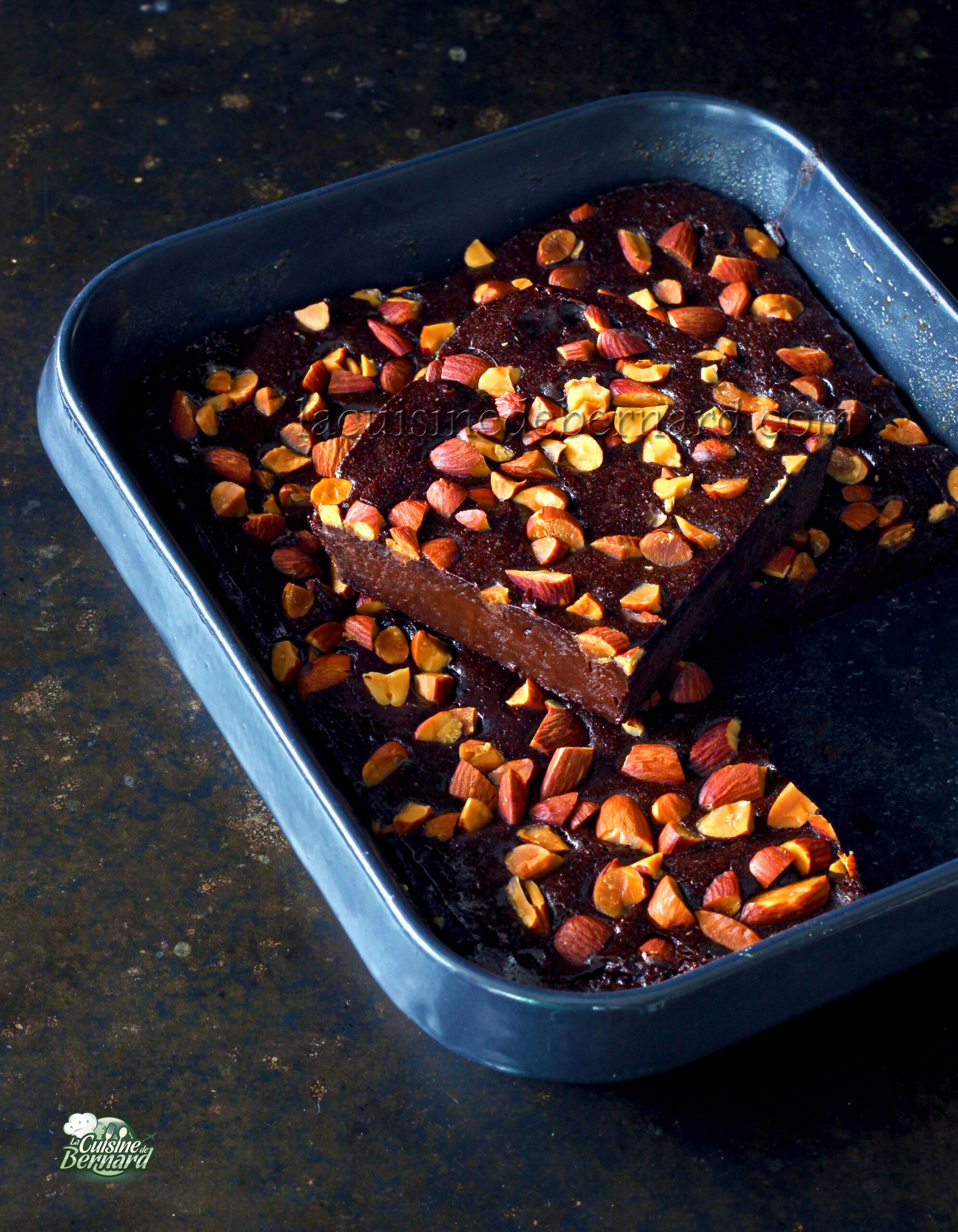
It’s been a long time since I made a chocolate cake on my cooking site. Here’s an ultra-chocolate fondant with roasted almonds. This is a low-sugar cake, with 70% cocoa chocolate, and naturally gluten-free, as it’s flourless. So yes, it’s rich and very, very chocolatey! Enjoy it in small slices with coffee.
For a 20x25cm rectangular mould (or a 22 square mould or a 24cm round mould):
- 230g of semi-salted butter
- 200g 70% cocoa dark chocolate
- 230g of egg
- 90g cane sugar
- 50g raw almonds
Melt together the semi-salted butter and dark chocolate.
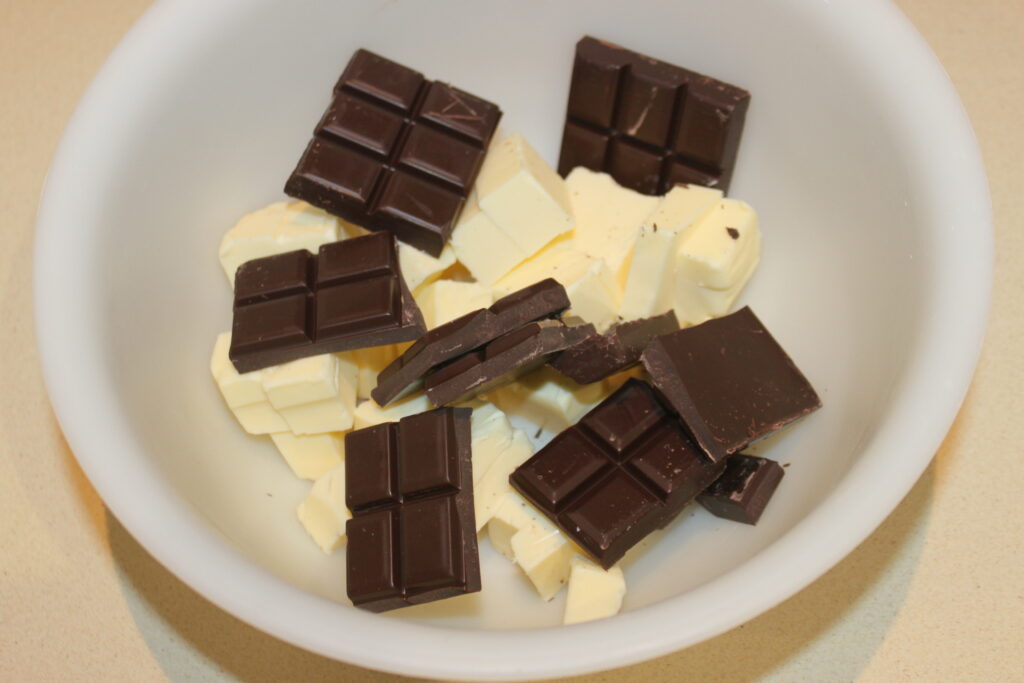
I make it in the microwave, heating to 900w for 1 minute 30. You can also do it in a bain-marie.
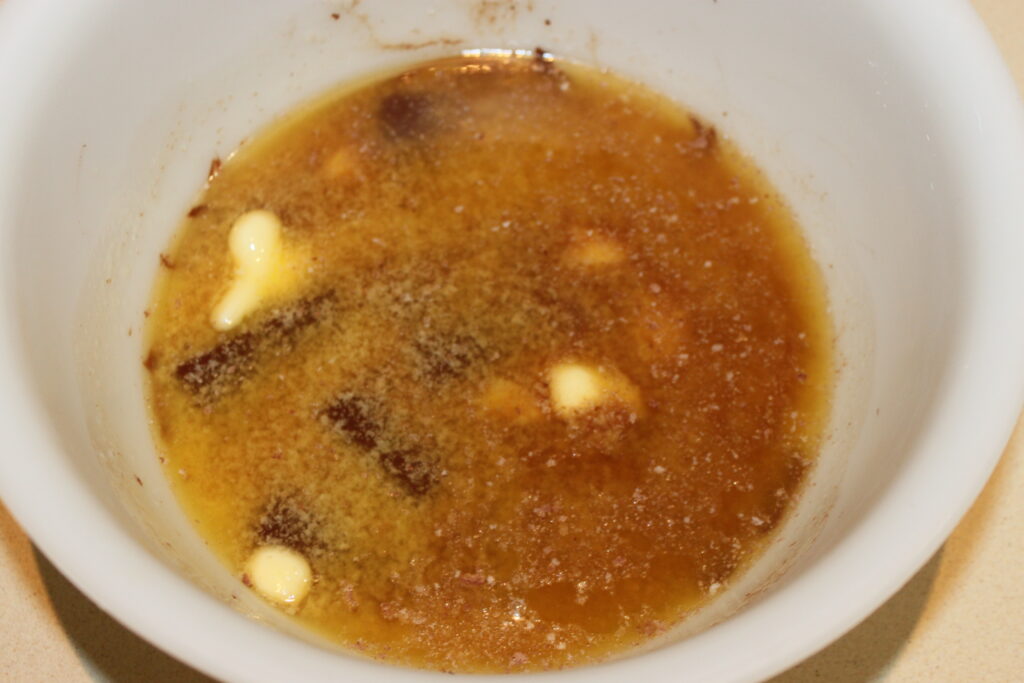
Mix well, then add the 90g cane sugar and mix again.
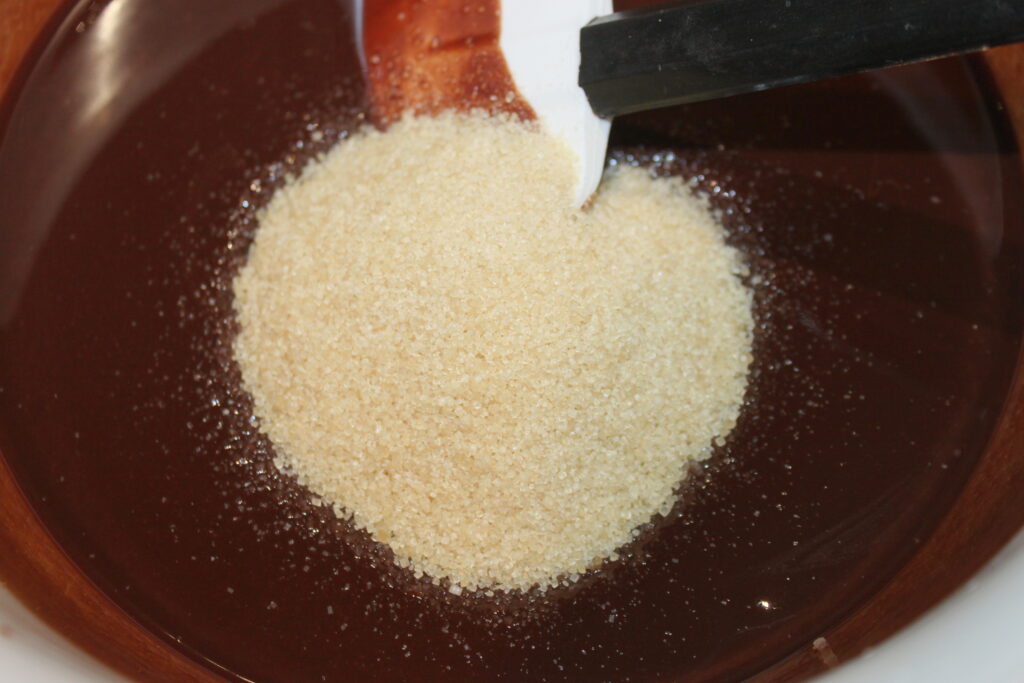
Add the 230g of egg (to do this, beat 4 large eggs or 5 medium eggs into an omelette and weigh out the quantity required). In the photo, I have 4 whole eggs that total 205g, but I’ve added 25g as an omelette.

If the butter doesn’t mix well, keep stirring briskly, as it will eventually become homogeneous.
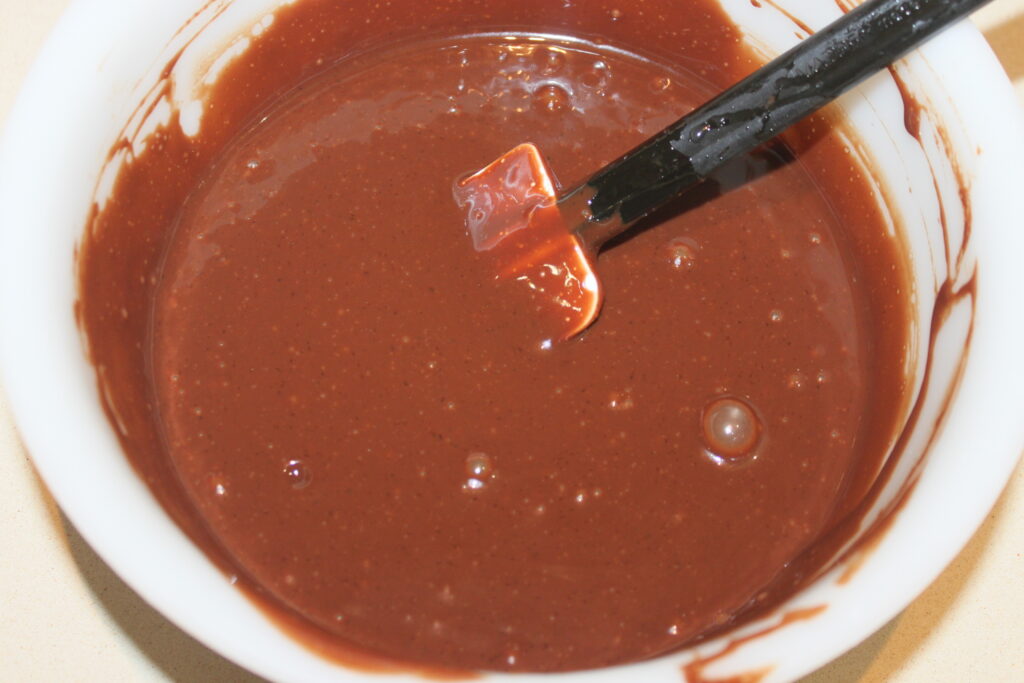
Butter the mould, then pour in the batter.
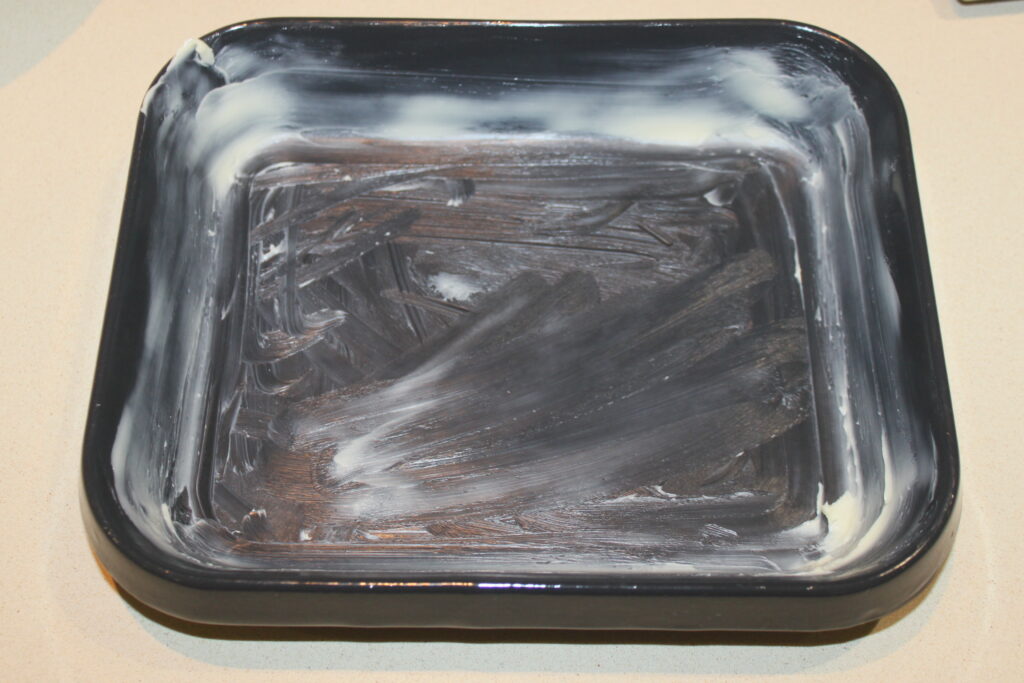
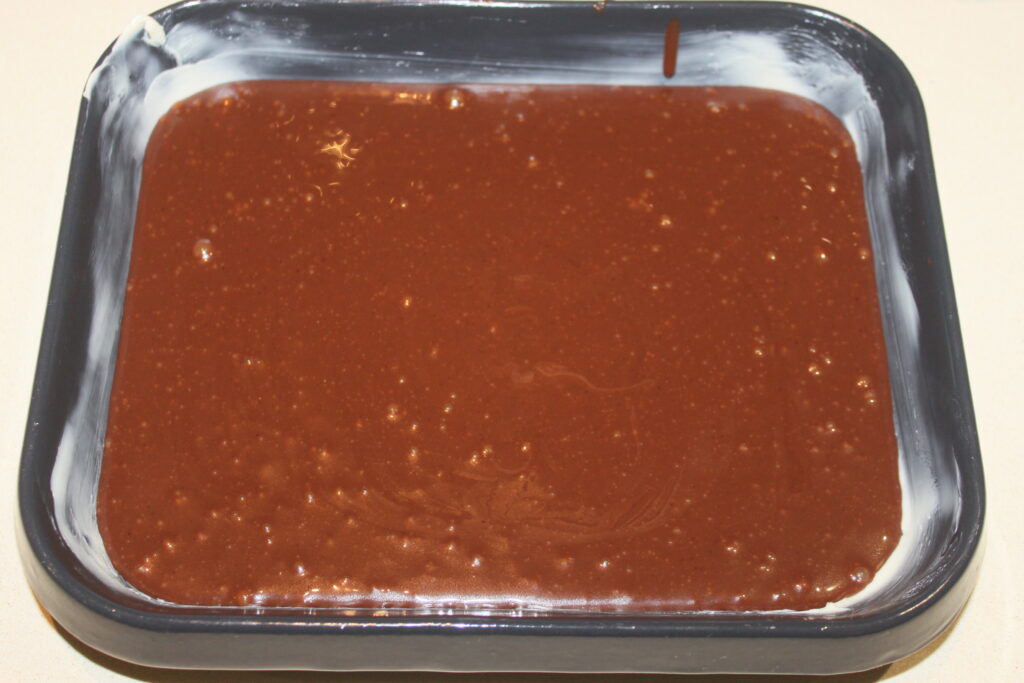
Chill the mold, while pouring the almonds into a baking tray and bake at 180°C over fan assisted heat for 17-18 minutes.
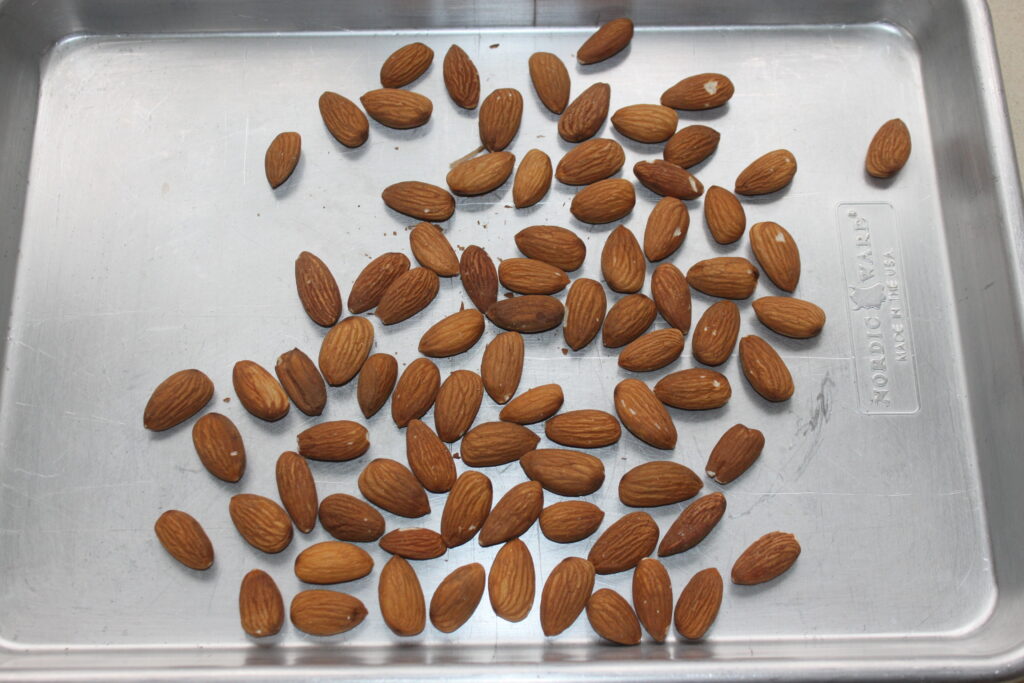
Once out of the oven, cut the almonds into fairly coarse pieces.
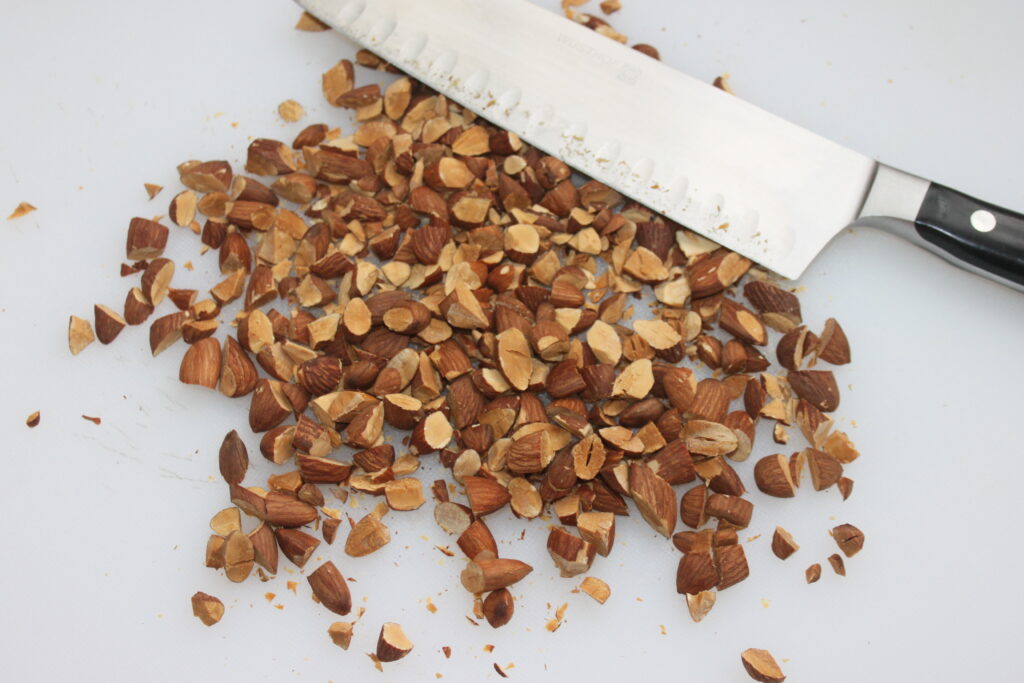
Remove the mould from the fridge and sprinkle the surface with crushed almonds.
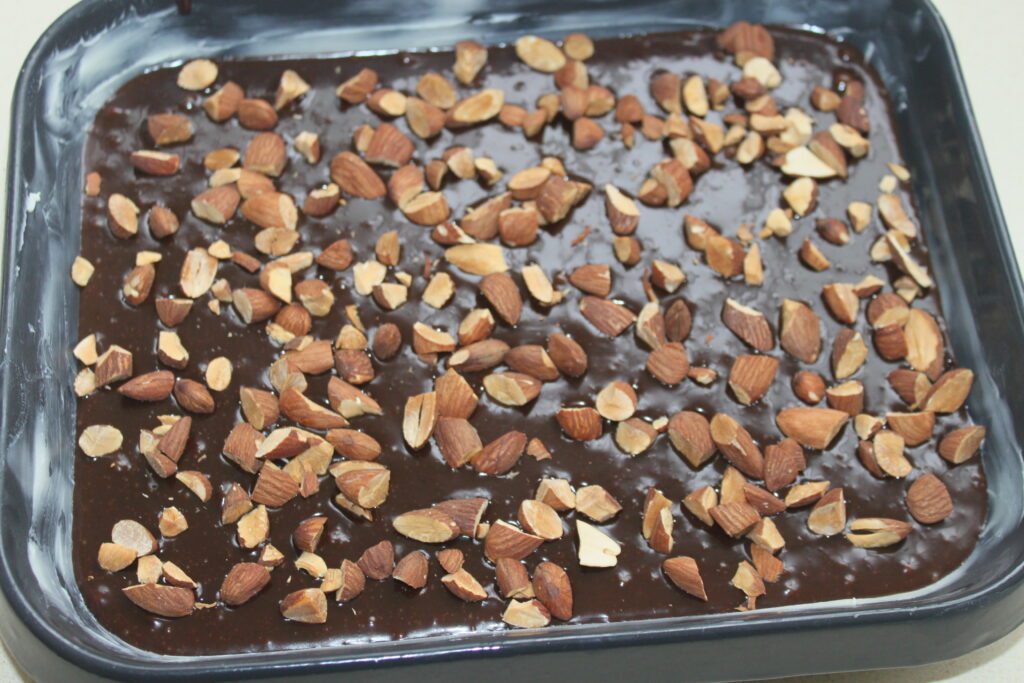
Place in the oven, still at 180°C, for 20 minutes.
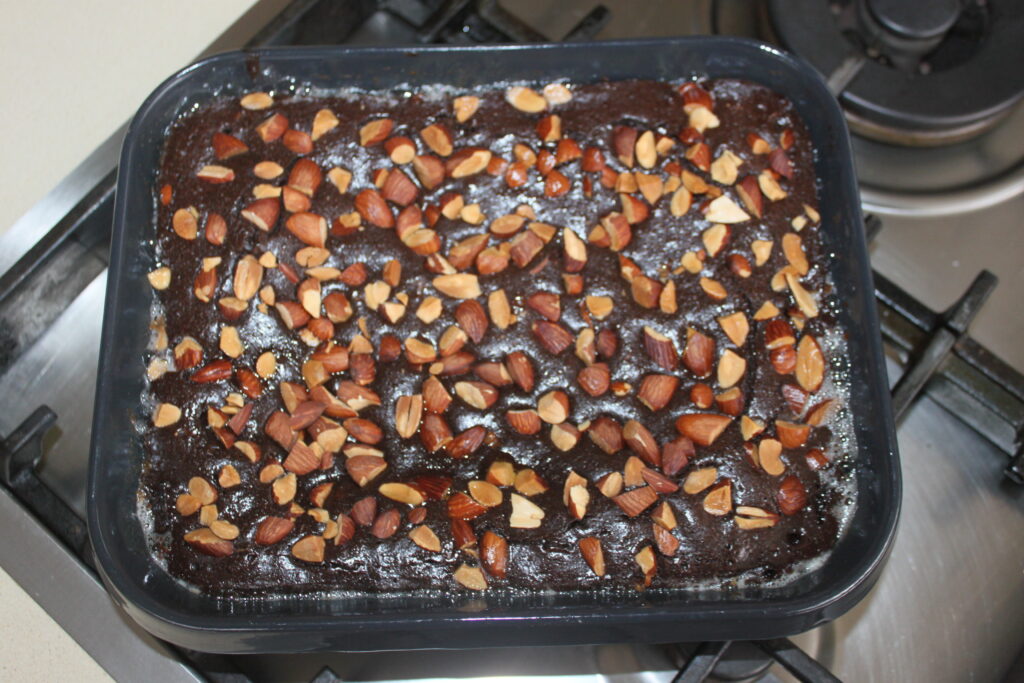
Leave to cool and enjoy at room temperature or fresh from the fridge!
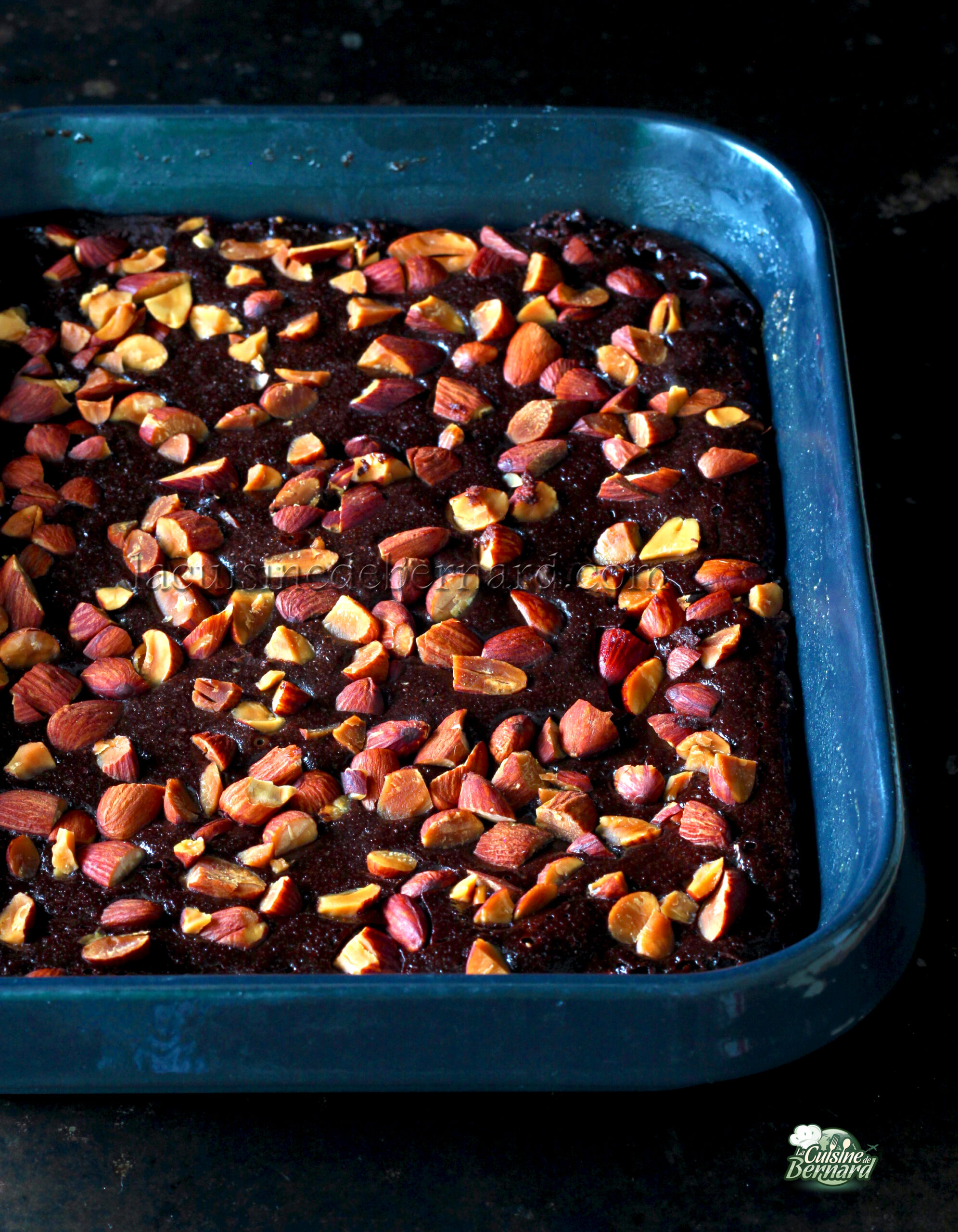
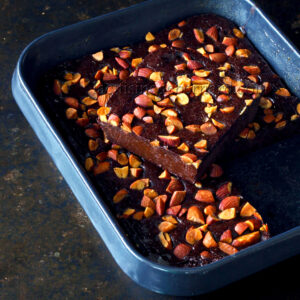
Fondant ultra chocolat et amandes grillées
Ingredients
Pour un moule de rectangulaire de 20x25cm (ou un moule carré de 22 de côté ou un moule rond de 24cm de diamètre) :
- 230 g beurre demi-sel
- 200 g chocolat noir à 70%
- 230 g œuf
- 90 g sucre de canne
- 60 g amandes crues
Instructions
- Mettez à fondre ensemble le beurre demi-sel et le chocolat noir.
- Je le fais au four à micro-ondes, en chauffant à 900w pendant 1 minute 30. Vous pouvez le faire aussi au bain-marie.
- Mélangez bien puis versez les 90g de sucre de canne et mélangez de nouveau.
- Ajoutez les 230g d’œuf (pour cela battez 4 gros œufs ou 5 moyens en omelette et pesez la quantité nécessaire). Si le tout tranche, c’est à dire que le beurre ne se mélange pas bien, continuez de bien mélangez, de façon assez vive, cela finira toujours pas devenir homogène.
- Beurrez le moule, puis versez la pâte.
- Mettez le moule au froid et pendant ce temps, versez les amandes dans une plaque et faites cuire à 180°C sur chaleur tournante pendant 17-18 minutes.
- À la sortie du four, coupez les amandes en morceaux assez grossiers.
- Sortez le moule du réfrigérateur et parsemez la surface d’amandes concassées.
- Mettez au four, toujours à 180°C pour 20 minutes.
- Laissez refroidir et dégustez à température ambiante ou bien alors bien frais sortant du réfrigérateur !
Nutrition
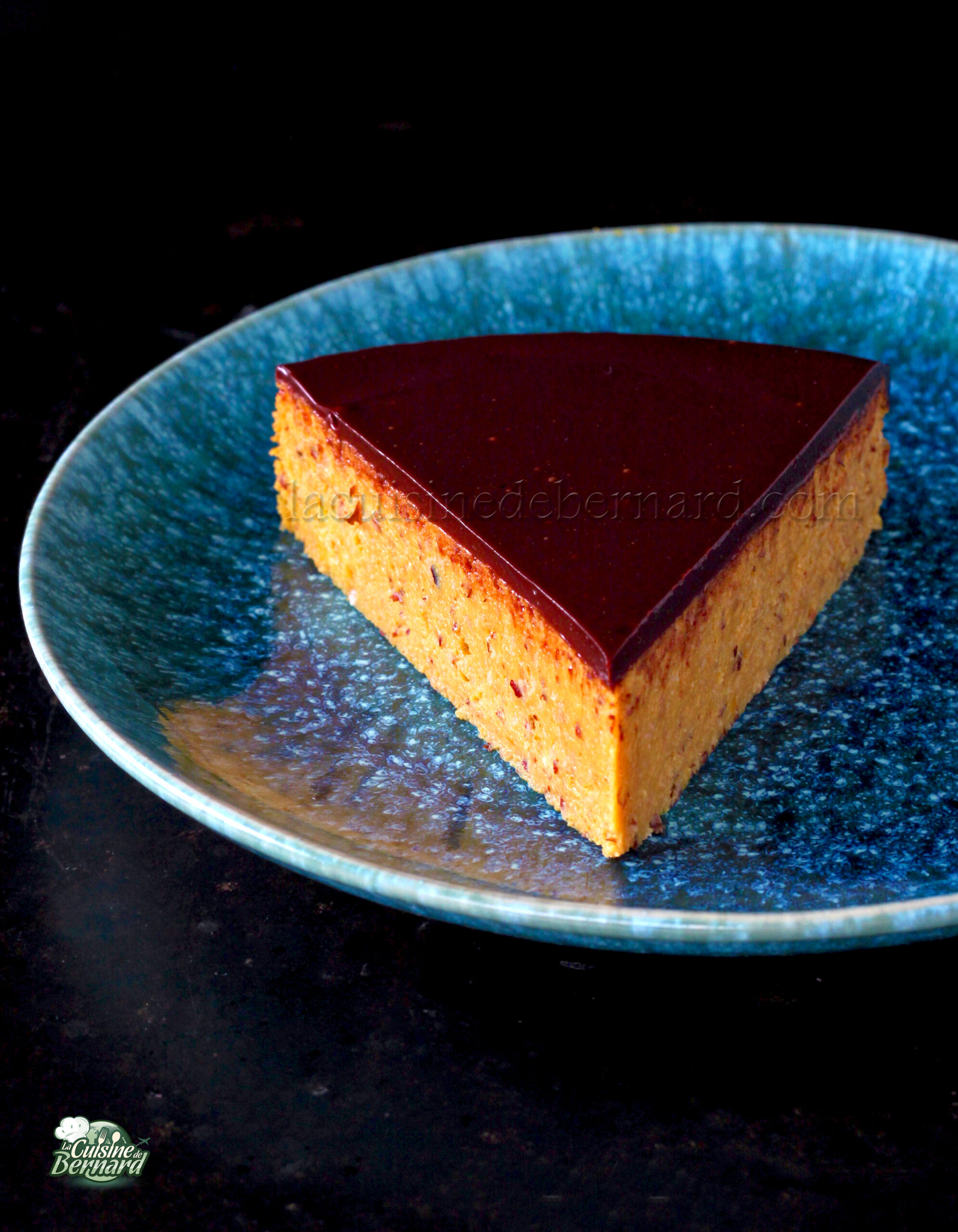
My friend Gaëlle, a pianist by trade, is also a fine cook, and if you have my latest book “La cuisine de Bernard” published by Flammarion, you’ll find her recipe for salmon and tuna tataki. It’s not the first time she’s agreed to share one of her delights on my site. So a thousand thanks to Gaëlle for this delicious orange cake. Here, the orange is cooked, then blended whole with the peel (organic oranges are essential) and mixed with other ingredients, including almond powder previously roasted in the oven. Once baked and cooled, then topped with a chocolate icing/ganache, this cake has an incredible consistency and taste! A must-try!
For a 23cm cake:
- 2 organic table oranges (about 180g each)
- 2 organic blood oranges (same weight as the others)
For the cake
- 600g cooked orange (this is the total of 3 of the 4 oranges above)
- 170g almond powder
- 120g whole cane sugar
- 280g egg (about 5 large eggs)
- 70g blood orange juice
- 55g deodorized coconut oil (or not for “deodorized”, it’s up to you)
For the chocolate ganache :
- 120g dark chocolate
- 80g full cream
Start by cooking three oranges (2 table and 1 blood) in boiling water for 1 hour. You can put a lid on during cooking. You’ll be left with a blood orange, which can then be squeezed.
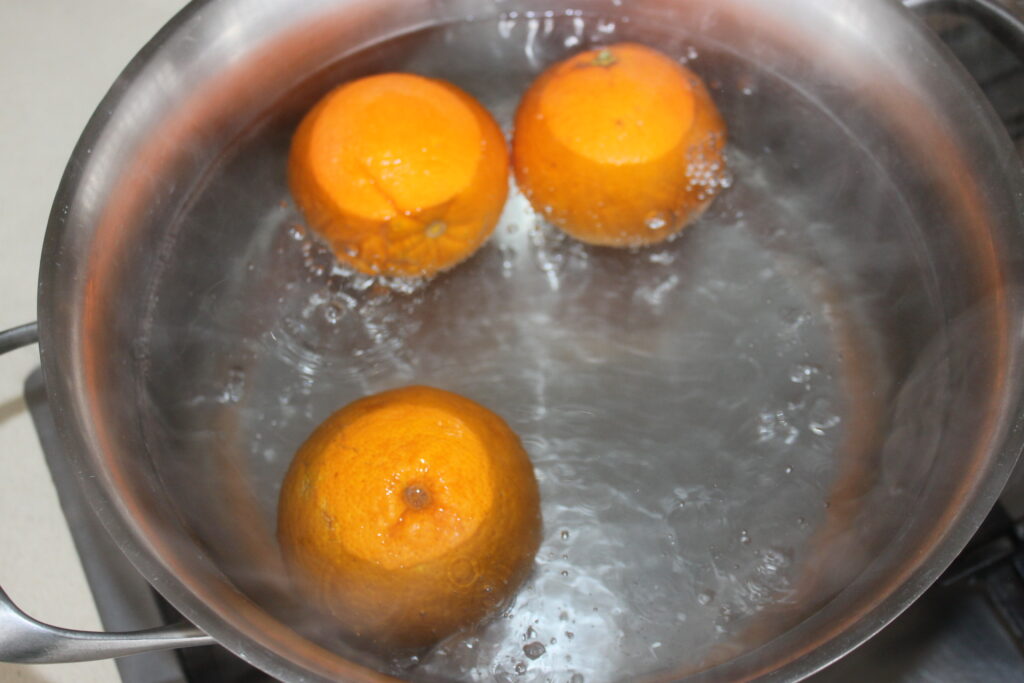
The oranges become soft after this treatment.
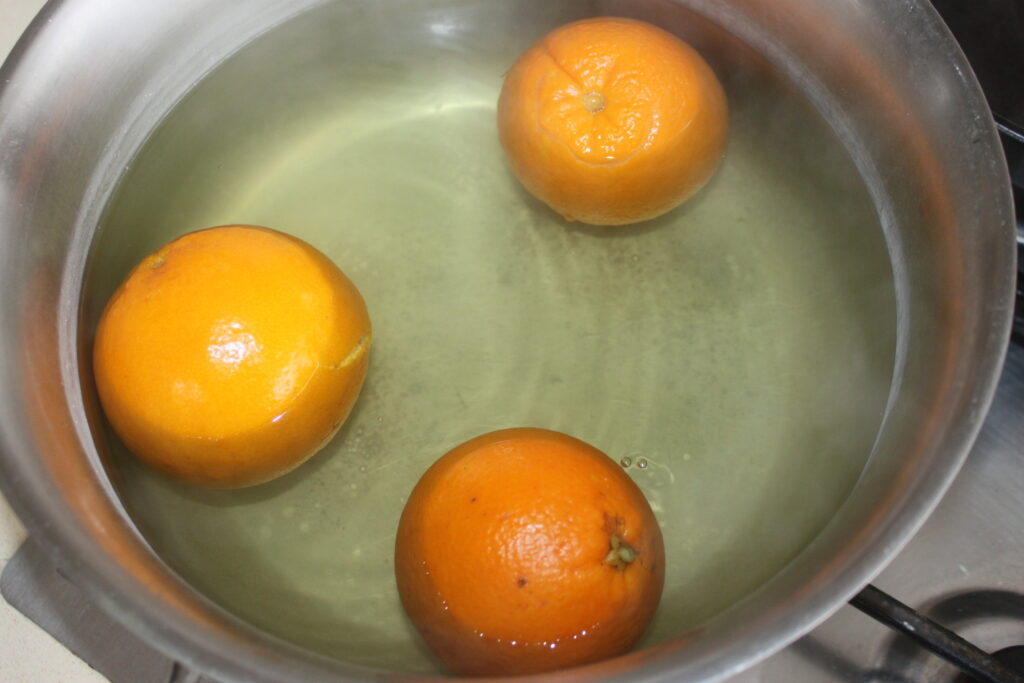
Let them cool out of the water.
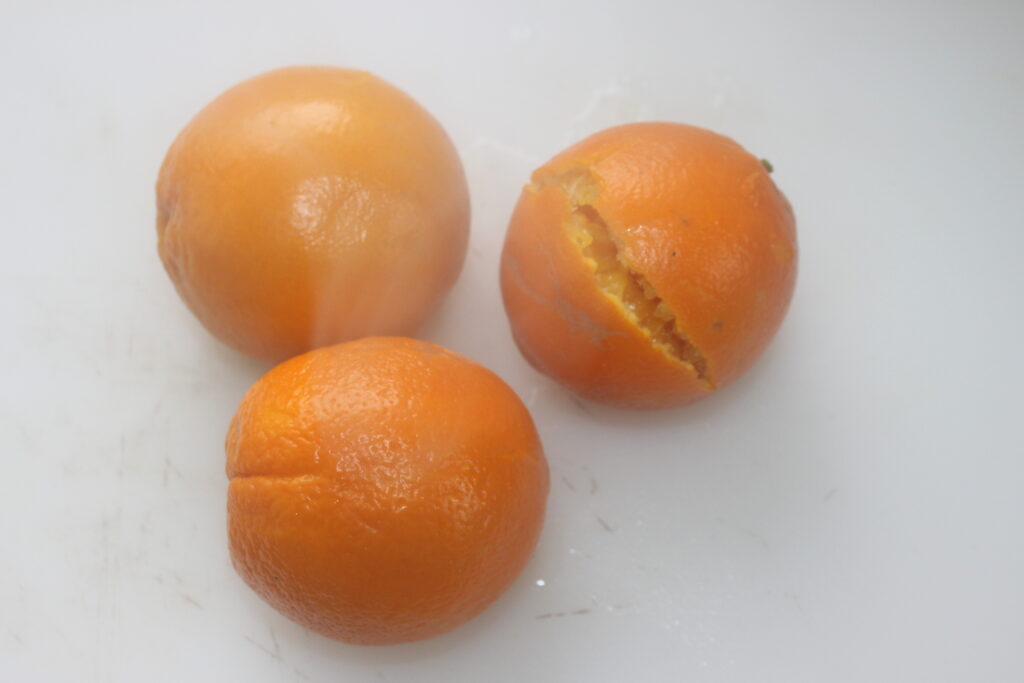
Meanwhile (or while the oranges are cooking), bake the almond powder at 170°C for 16 minutes.
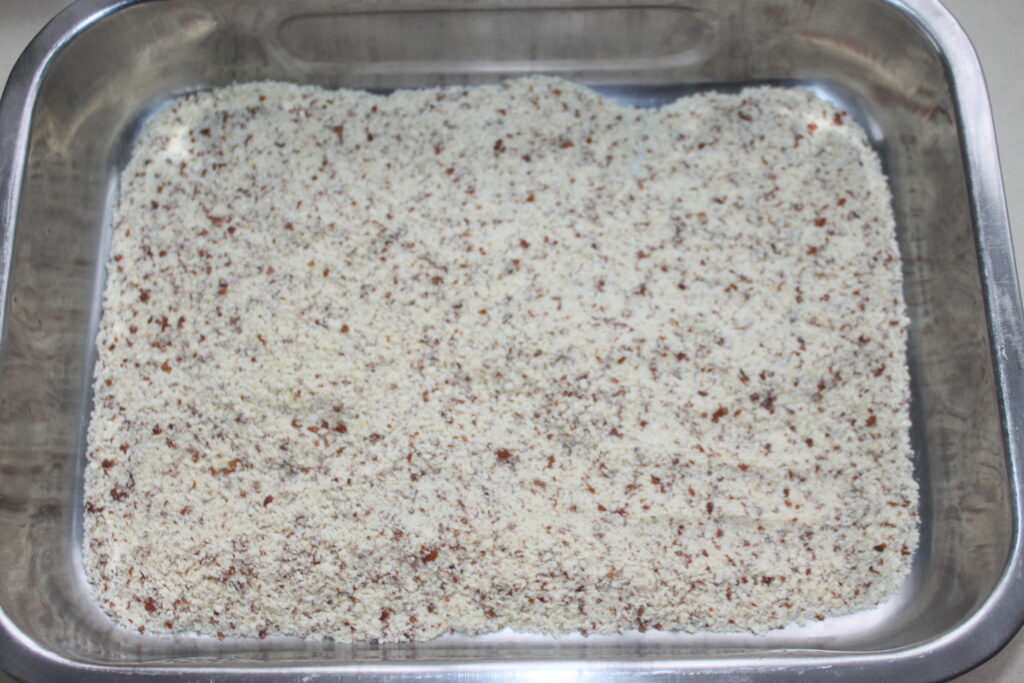
Slightly tinted.
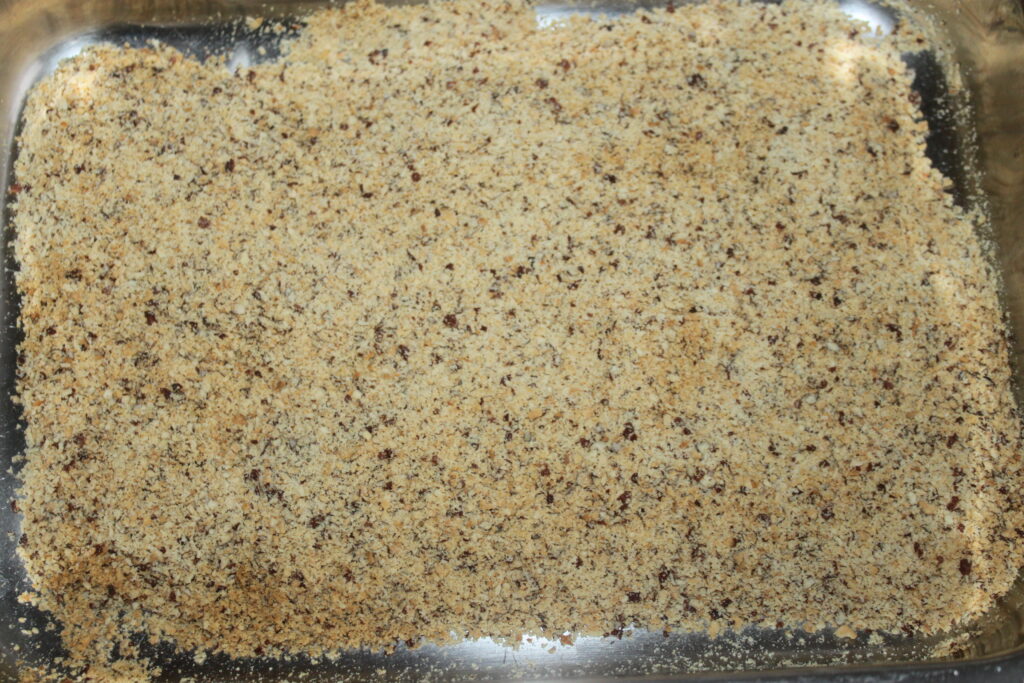
When oranges can be handled, cut them into pieces and remove any seeds.
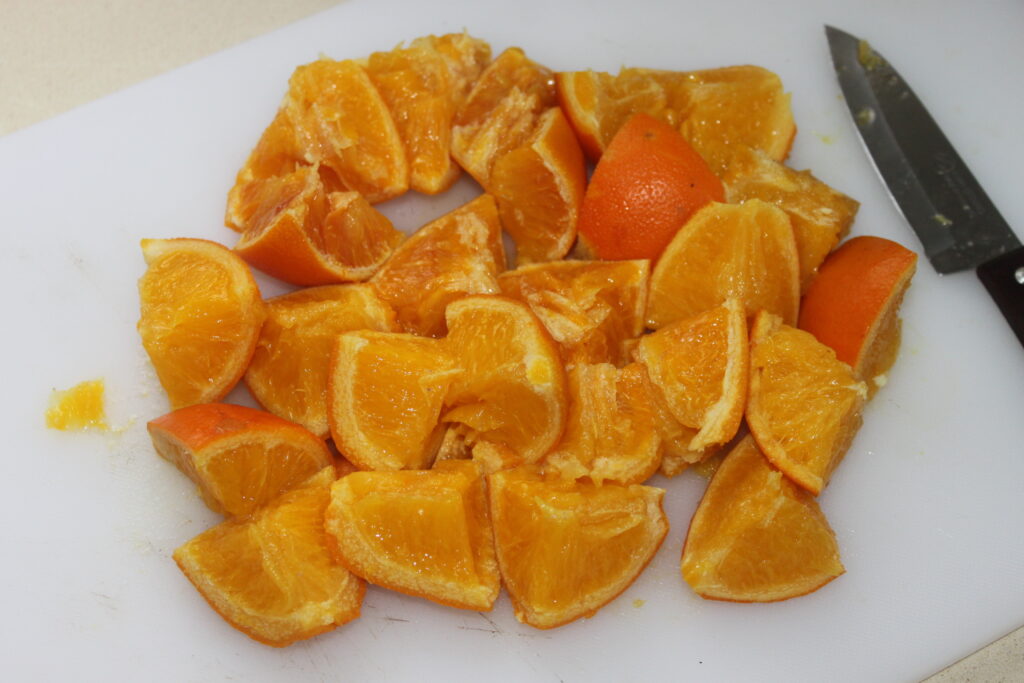
Weigh out 600g and place in a blender with the wholegrain cane sugar and eggs.
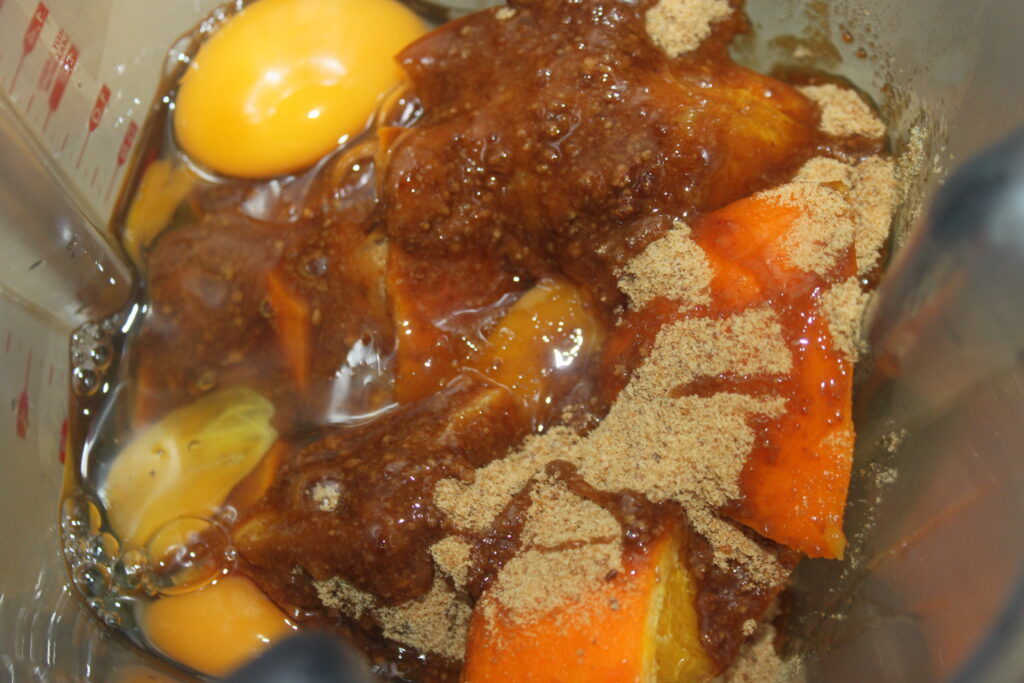
Blend to a creamy consistency. Pour into a container.
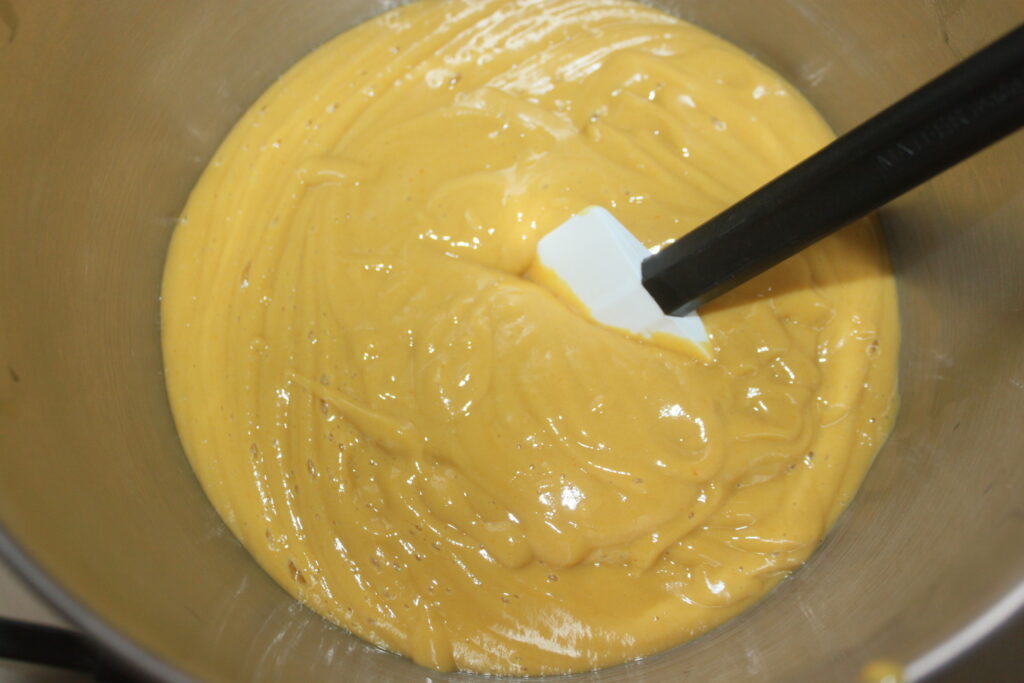
Squeeze the last blood orange.
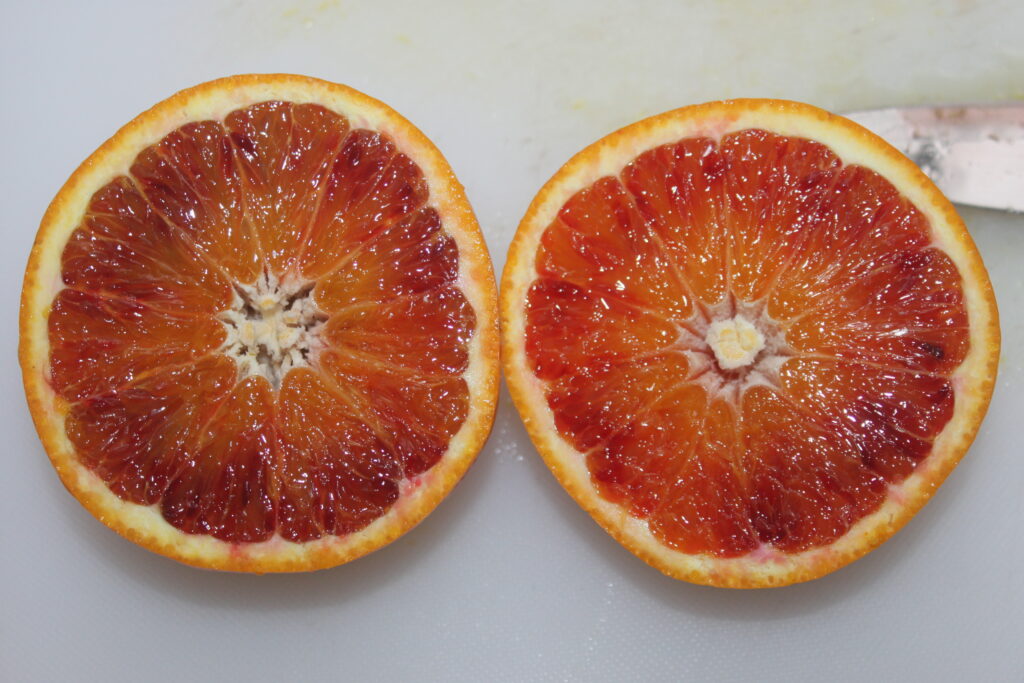
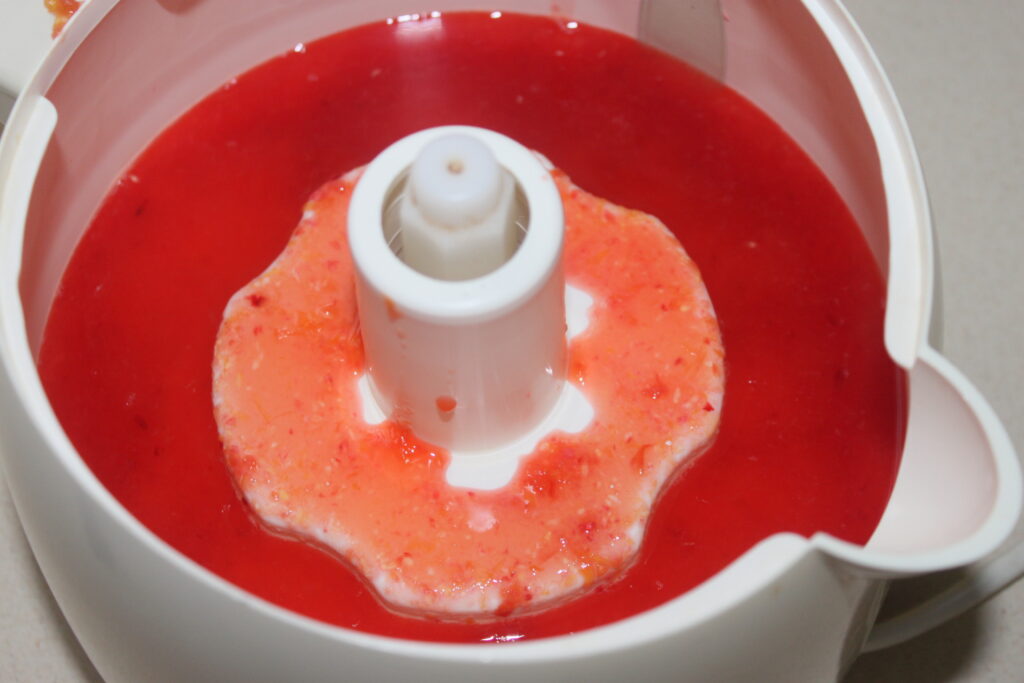
Pour 70g of the juice into the dough.
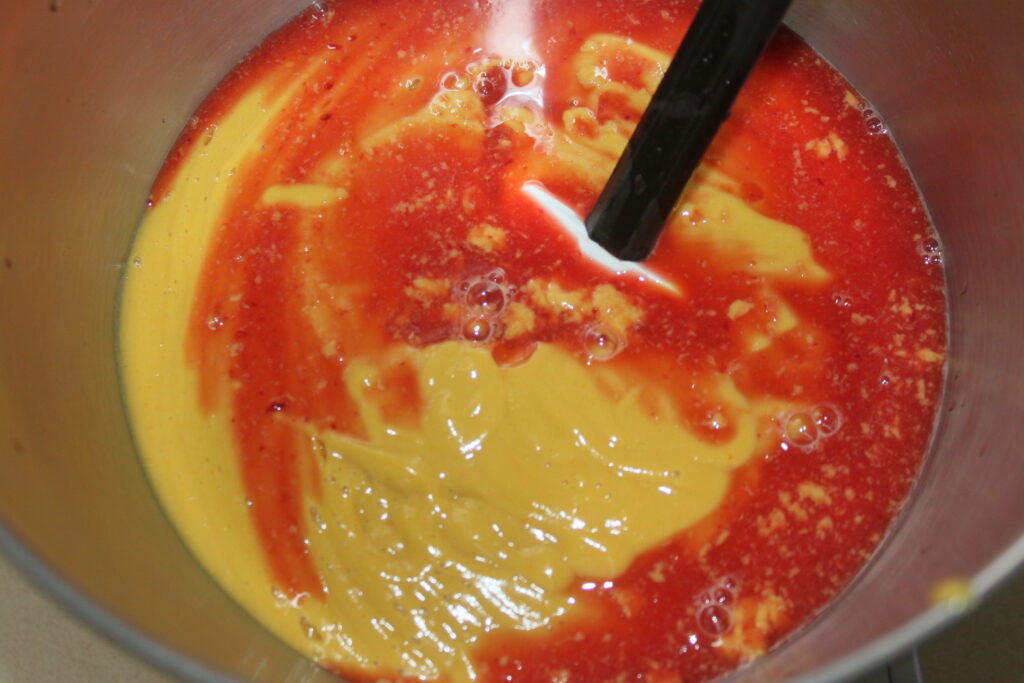
Pour in the melted coconut oil and almond powder.
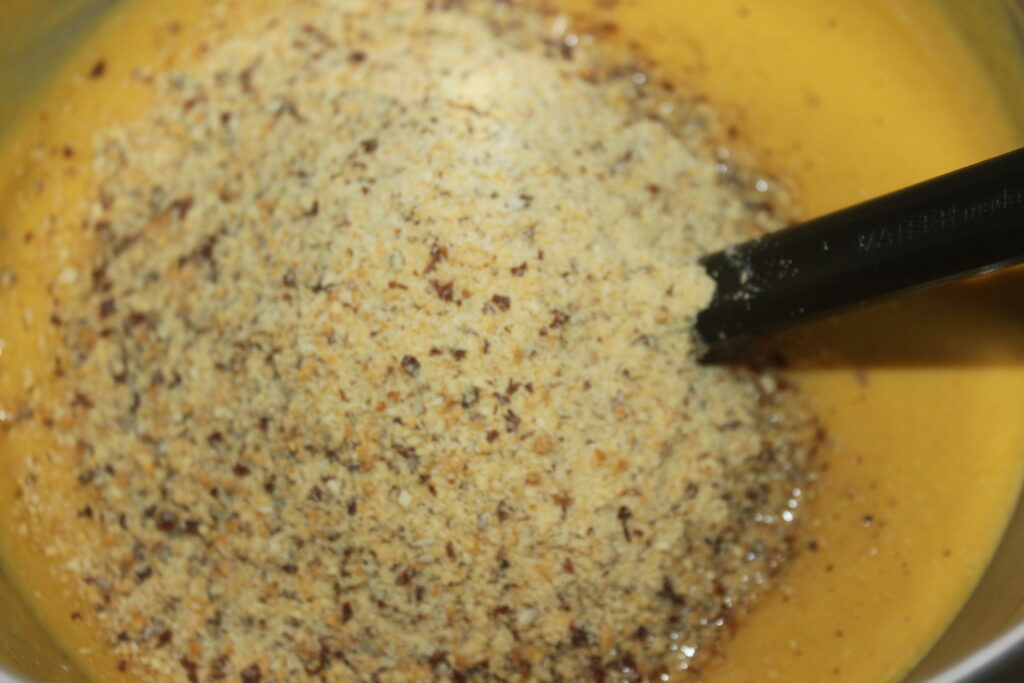
Mix well, then pour into a mold (in this case, a removable springform pan) lined with parchment paper. You can also apply grease to the inner edge.
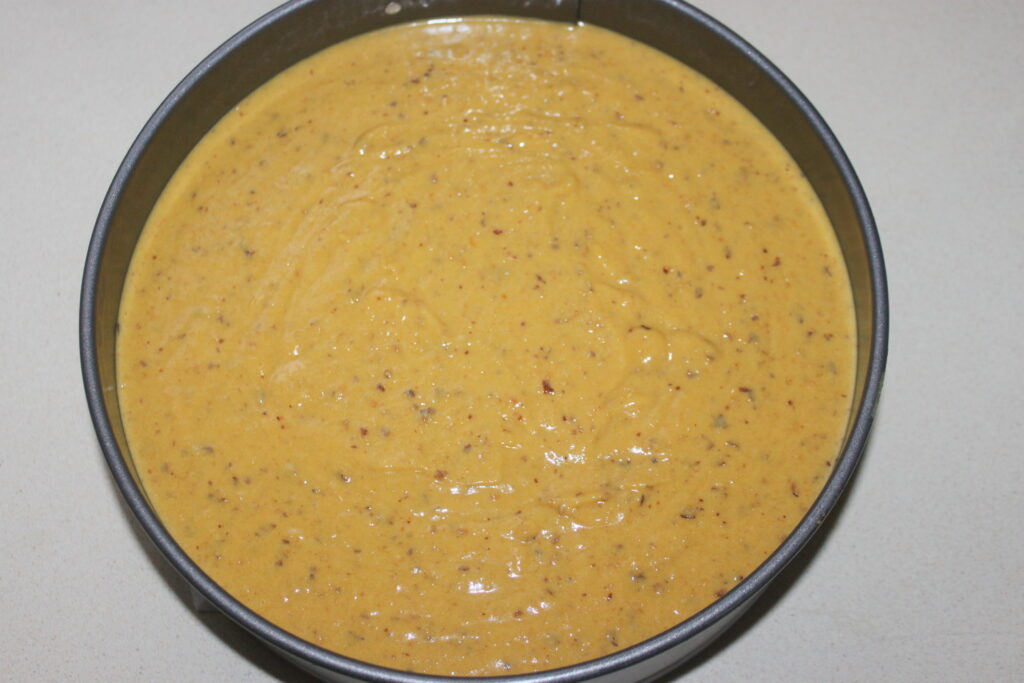
Bake at 175°C for 45 minutes over static heat (not fan assisted).
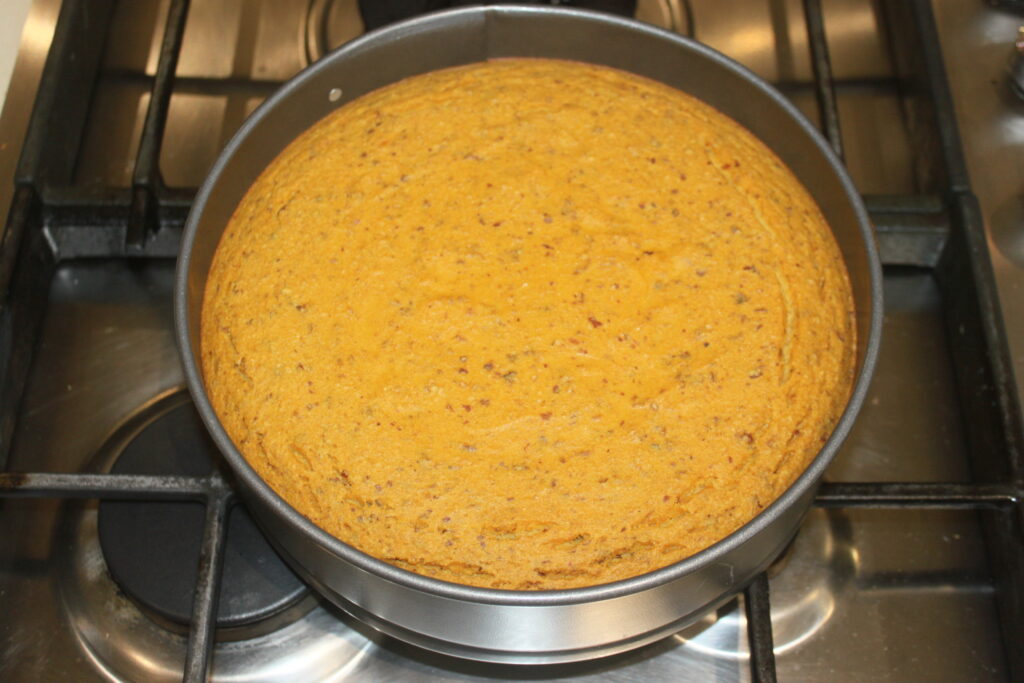
Leave to cool, then make the ganache by melting the cream and chopped dark chocolate together in a microwave oven. Mix well, then pour over the cake and shake to smooth. You can also tap the mold on the work surface to even out the surface.
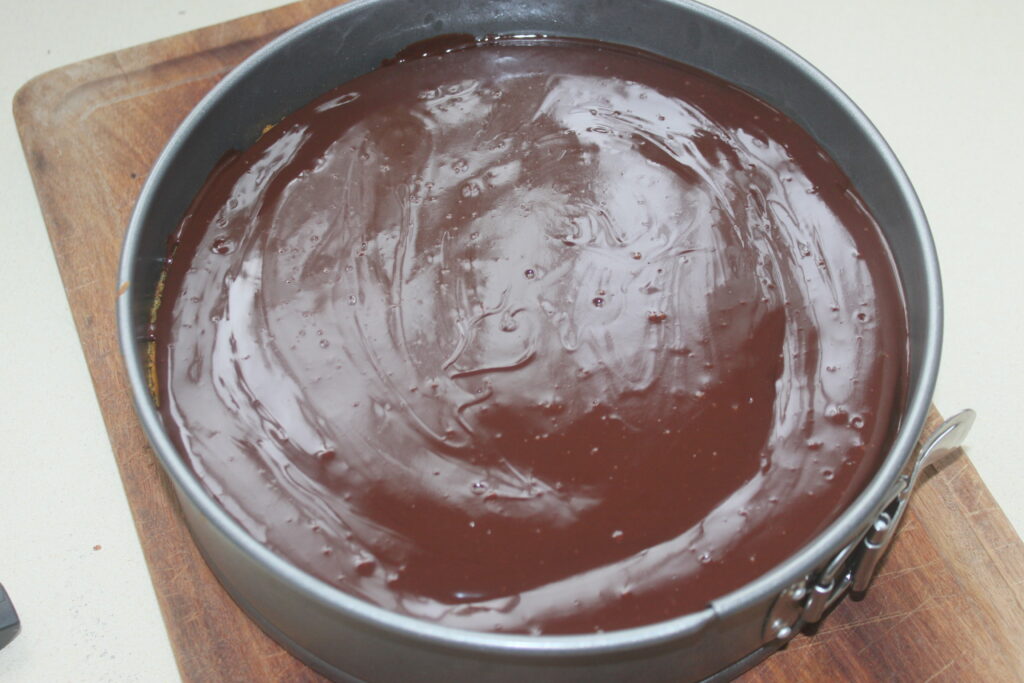
Leave to cool before chilling for at least 4 hours before serving. Eat well chilled.
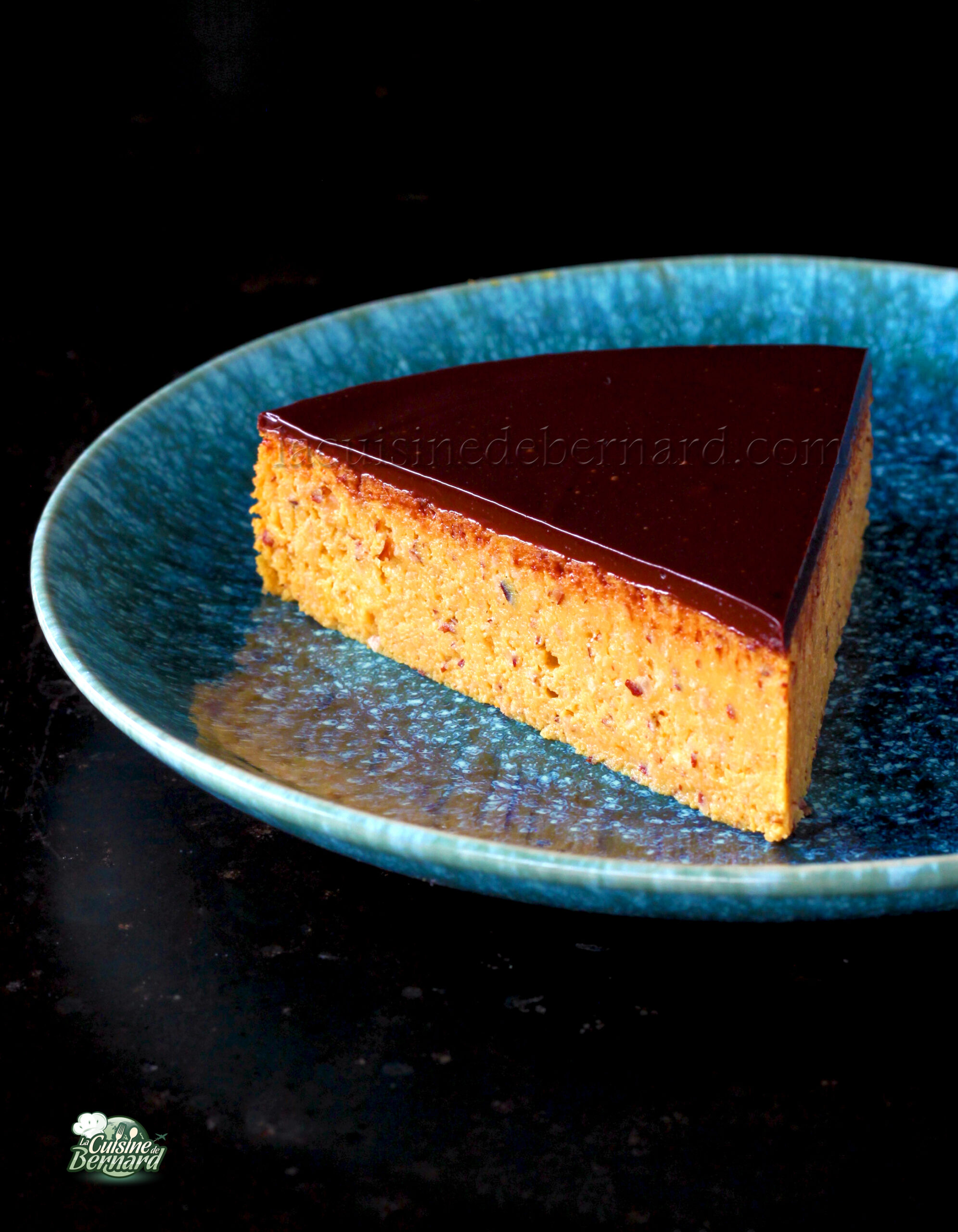
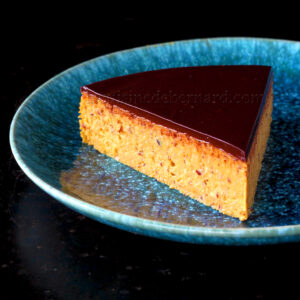
Orange and almond cake
Ingredients
For a mould of 23cm :
For the cake
- 600 g baked orange (this makes a priori the total of 3 of the 4 oranges above)
- 170 g almond powder
- 120 g whole cane sugar
- 280 g eggs 5 large eggs
- 70 g blood orange juice
- 55 g coconut oil
Ganache:
- 120 g dark chocolate
- 80 g full-fat liquid cream
Instructions
- Start by cooking three oranges (2 table and 1 blood) in boiling water for 1 hour. You can put a lid on during cooking. You’ll be left with a blood orange, which can then be squeezed.
- Oranges become soft after this treatment. Let them cool out of the water.
- Meanwhile (or while the oranges are cooking), bake the almond powder at 170°C for 16 minutes. Slightly tinted.
- When oranges can be handled, cut them into pieces and remove any seeds.
- Weigh out 600g and place in a blender with the wholegrain cane sugar and eggs.
- Blend to a creamy consistency. Pour into a container. Squeeze the last blood orange. Pour 70g of the juice into the dough.
- Pour in the melted coconut oil and almond powder.
- Mix well, then pour into a mold (in this case, a removable springform pan) lined with parchment paper. You can also apply grease to the inner edge.
- Bake at 175°C for 45 minutes over static heat (not fan assisted).
- Leave to cool, then make the ganache by melting the cream and chopped dark chocolate together in a microwave oven. Mix well, then pour over the cake and shake to smooth. You can also tap the mold on the work surface to even out the surface.
- Leave to cool before chilling for at least 4 hours before serving. Eat well chilled.










